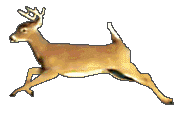Posts
Aging Coues
All wild ungulates (deer, elk, pronghorn, bighorn sheep, etc.), can be aged fairly accurately by examining their teeth. This can be done two ways. One way is to examine the teeth under a microscope and the other is to look at wear and replacement patterns of all the teeth in the lower jaw. Using the number of tines on a buck’s antlers is not an accurate way to estimate age. Bucks in exceptional condition can have more tines than those of the same age which are in poor condition. And older bucks may have heavy beams but fewer points than a young buck.
Aging by counting cementum annuli under a microscope
This method requires the extraction of one of the large front incisors from the lower jaw and slicing the root extremely thin. These slices are then stained and examined under a microscope. As a wildlife biologist, I have pulled and collected hundreds, if not thousands of teeth from ungulates. Most of the time biologists send those teeth to a lab either at their Game and Fish Department or to one in Montana (Matson’s) to be examined. But I have also had jobs where I spent hours cutting, staining and examining slices of deer teeth. This method is very interesting and is similar to counting annual rings in a cut tree trunk. Deer lay down a layer of cementum in their teeth each year. A specialized machine is used to slice microscopic sections off of the tooth root. After staining, the slices of tooth will show annual rings.
Counting cementum annuli is the most accurate method of aging deer older than 3.5 years. In some species you can gain additional information from this technique. Matson’s lab in Montana has correlated the years that a bear has young with thin layers of cementum (perhaps because the bear is putting more resources into the pregnancy). So by looking at a slice of tooth from a female black bear, a biologist can tell how many times the bear has produced young. This works well in bear because they tend to only have young every other year. But for most deer, reproduction is an annual event.
If you have a buck that you would like aged, pull the front incisors from the lower jaw (deer don’t have upper incisors) and contact Matson’s lab for information on how to get it aged. It is just as expensive for the lab to analyze one tooth as it is for 4-5, so you might wait until you have several or get your hunting buddies to collect teeth too.
Make sure when you extract the tooth that you do not break off the root. The easiest way to extract them that I know of is to use a pocket knife to slice down deep into the gum on each side of the tooth. Then wiggle the knife on each side of the tooth so as to loosen things up. Do this on both of the front incisors. Then place the blade of the knife behind the teeth, with the width of the blade parallel to the width of the teeth. Push the knife blade into the gum and gently pry the knife toward you. This should push both teeth forward and down from the rest and then you can slice any remaining flesh from the root to fully extract them.
For more information visit Matson’s Laboratory, LLC – Home Page.
You can email Gary Matson at gjmatson AT montana DOT com
Matson’s Laboratory, LLC
8140 Flagler Road
P.O. Box 308
Milltown MT 59851
Aging by tooth wear and replacement
Another way to use a deer’s teeth to determine it’s age is by looking at wear and replacement. Deer develop their teeth in a predictable pattern. In addition, over time, the teeth are ground down and that wear can give an indication of age. This method is most accurate for deer less than 3.5 years old. For older deer, the amount that the teeth wear down annually varies according to what they are eating. A deer that lives in an environment with a lot of sandy, gritty soil will wear his teeth down faster than one that doesn’t. Many Game and Fish offices have a “deer jaw board” which has examples of deer jaws of known age deer so that one can see how the teeth wear in that particular area. When I get some photos of some jaws, I will post them. An excellent reference for aging all big game animals in Arizona has been published by the Arizona Game and Fish Department. It gives a great description and has pictures demonstrating the tooth replacement patterns.
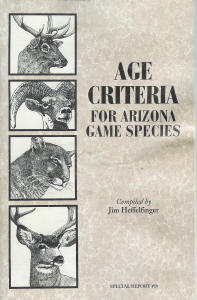
Click on the image to go directly to the Arizona Game and Fish Department web site. I don’t see this guide listed for purchase at the web site, but you can call the Dept. at (602) 942-3000 to ask where you can purchase a copy. I believe it is only $3.
To use this method of aging a deer, you want to look at the lower jaw. A deer has long incisors on the front part of the jaw and premolars and molars on the back the jaw. In fawns, you will only see four back teeth (3 premolars and 1 molar). A yearling Coues deer will have 3 premolars and the third premolar will have three cusps. The molars of a yearling are still coming in, but you should see three molars with the last molar only partially erupted. A deer that is 2.5 years old will have all its adult teeth in and the third premolar will only have two cusps. There is very little wear evident on the teeth of a 2.5 yr old. Because a deer does not replace any of its teeth after 2.5 years, the teeth start to show more wear with each passing year. The first molar (the fourth tooth on the back part of the jaw) is the one that will show the most wear and is the one to key in on. Look for the width of the dentine (brown parts of top of tooth) compared to the width of the enamel (white part on top of tooth). As the tooth wears it will have wider dentine sections compared to the enamel. And the cusps of the teeth will wear down and become smooth. A deer that is 3-5 years old will still have some cusps to it on the first molar, whereas on an older deer that molar will be very smooth. Here is a link to an online site that shows pictures of this wear pattern. For Arizona specific information, you will want to purchase a copy of the publication put out by Arizona Game and Fish – its only $3 and well worth it.
Coues Deer Sign
Deer leave a variety of sign that can let you know where they have been even if you don’t see them. The most obvious of signs are scat (feces) and tracks. Coues deer scat is in the form of small pellets. The pellets will vary in color from greenish (when really fresh) to brown or black and even gray or white (when really old). The photos below show some of the variation in colors. Coues scat can be clumpy if the deer is eating a really moist diet. Deer scat will also be moist when fresh, but dries fairly quickly. Scat that is somewhat fresh may appear dry on the outside but still be moist on the inside.
All photos by A. Moors.
Scat
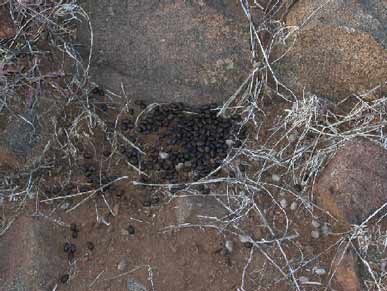
Coues deer scat next to rock
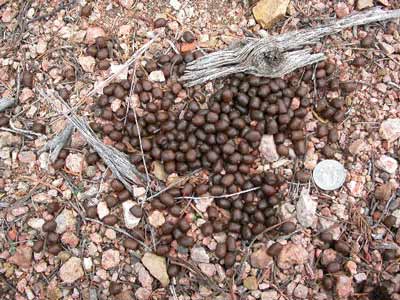
There is a quarter in this photo to show scale
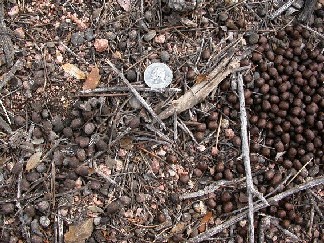
This photo shows older scat on the left and newer scat on the right.
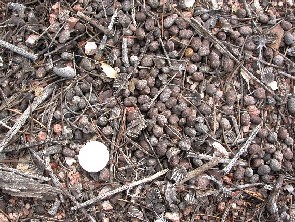
Very old scat showing the whitish-gray color.
Tracks
Deer also leave tracks when they travel through an area. Good places to look for tracks include washes, hillsides, and saddles. Also check any area that has muddy soil like around a stock tank, spring or river. Looking at tracks can tell you the size of the animal and what it was doing there (i.e., running, walking, pawing at the ground). White-tailed deer and mule deer have very similar tracks, but mule deer are larger. Mule deer tracks tend to be about 2.5- 3 inches long while Coues tracks tend to be 2 to 2.5 inches long. Sometimes people confuse javelina and whitetail tracks. Javelina tracks are fairly easy to distinguish due to their smaller size (1 to 1.5 inches long) and blunter tips (see photos below).
Tracks can help determine when an animal uses an area.
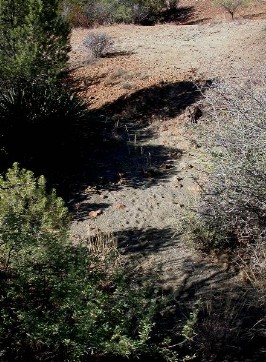
This photo shows a game trail that crosses a dry sandy wash.
Coues Deer Habitat
The white-tailed deer is highly adaptable. It is found from Mexico and Central America to Canada and throughout the United States. It survives in environments that are subject to extremes in temperature – both heat and cold. It lives in remote areas where few humans ever go and it survives in highly populated areas as well.
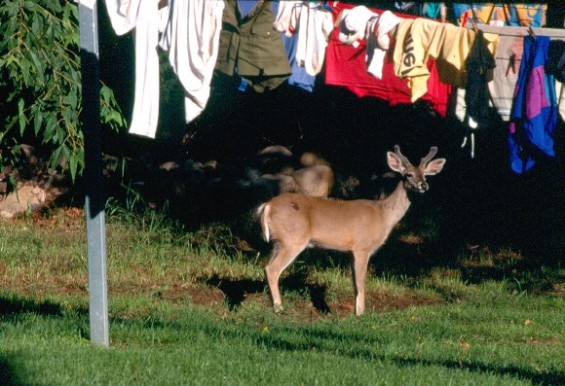
Photo courtesy of Wade Sherbrooke, Southwestern Research Station, Portal, Arizona.
So what is good Coues deer habitat? When evaluating habitat, it helps to think of the elements that are needed for any animal – food, water, shelter, and space to live. Good Coues habitat is any area that provides adequate amounts of each of those factors. The best Coues habitat will provide a large diversity of foods by having a mix of open areas and brushy areas. Coues are primarily browsers, so shrubs must be available for them. However, Coues highly prefer forbs and those grow more commonly in open areas such as a grassy meadow or grassland found at the edge of juniper woodland.
Coues deer seem to be most numerous in woodland areas about 4000-6500 feet in elevation that have Madrean evergreen oaks or areas of oak mixed with juniper and pinon pine. However, Coues deer can be found in the more open Sonoran Desert and in Semi-Desert Grasslands. They can also be found in Ponderosa Pine forests. I have selected some photos below to show some of the variety in habitat that Coues deer will use.
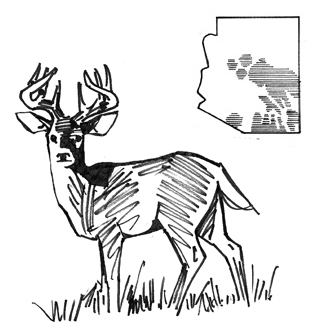
The illustration above shows the distribution of Coues deer in Arizona. Those occupied areas tend to be within the 4000-6500 ft. range in elevation. Illustration by Bill Quimby. For a detailed map of the density of Coues deer in Arizona, check out the “Where to Hunt” section. Coues deer are also found in Mexico and southwestern New Mexico.
The best Coues habitat will have several permanent water sources since these deer need them to survive. The home range of a Coues is about 1-2 square miles. Deer density is highest within 0.5 – 1 mile of a good water source. Maghini and Smith (1990) suggested that a density of 1 water source for every square kilometer (approx. 0.5 sq. miles) is best for female Coues. Based on their research in the Santa Ritas in Arizona, Ockenfels et al. (1991) suggested that a density of one water source every 2-3 sq. km would meet deer requirements. They also found that the first 400 m (roughly equal to a quarter mile) around a water source was used far more often than areas greater than 1200 m away from water.
If you are looking for an area that has a high density of Coues deer, look for a place that has a good mix of thick and open vegetation types between 4000-6500 feet in elevation and that has springs or water tanks scattered throughout the landscape within about a 1/2 to 1 mile of each other.
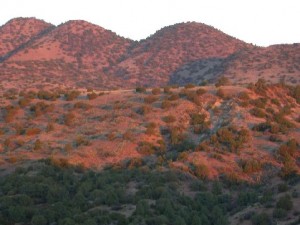
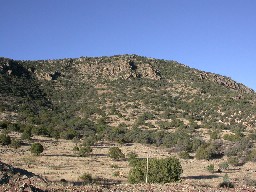
Juniper-oak woodlands with large populations of Coues deer. These two areas have a good mix of white and Emory oak, mesquite, acacia and pinon pine along with the juniper. The variety of topography in these areas provides places for many different types of plants to grow (trees, browse, grass and forbs). This excellent diversity of plants along with good water sources makes these places great habitat for Coues. Deer will feed through the open areas in early morning and evening and move into the thicker areas to bed.
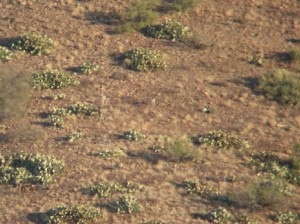
Coues will also use more open habitat of mesquite and prickly pear. There are 3 small bucks near the center of this photo. Photo by A. Moors.
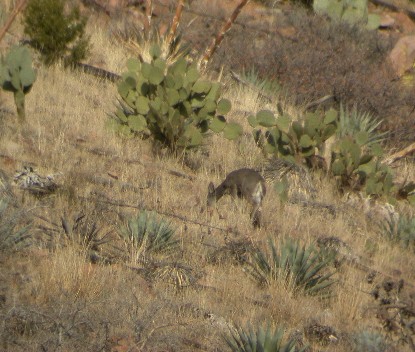
Coues deer feeding between some prickly pear and agave. This deer fed on this open slope in the morning and then moved down into a drainage with thick shrubs for bedding. Coues deer will even use drier areas than this, areas with less grass and more cactus and ocotillo. Photo by A. Moors.
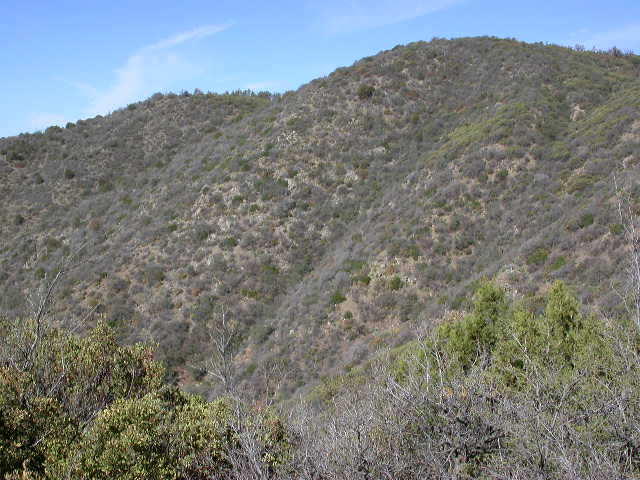
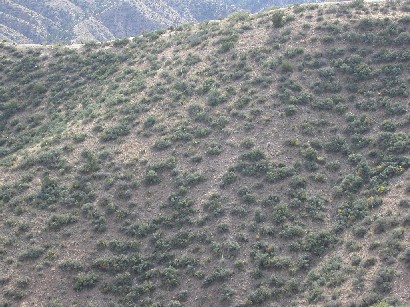
These brushy hillsides provide some good Coues habitat. It can be extremely difficult spotting a Coues deer in this type of habitat. Photos by A. Moors.
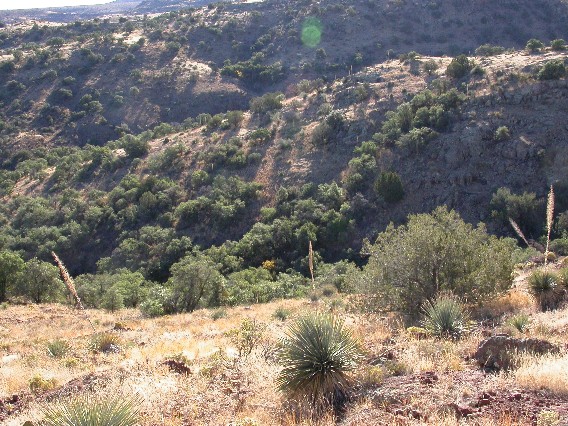
This area has a good mix of oak trees, juniper, shrubs and grass. Coues deer feed in the more open areas and bed in the thick vegetation lower in the canyon. Photo by A. Moors.
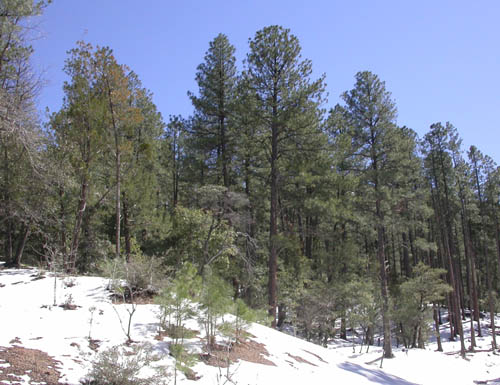
Ponderosa Pine forest can make good deer habitat if there is enough diversity of other species. A variety of oaks, shrubs, and forbs help make this habitat productive for Coues deer.
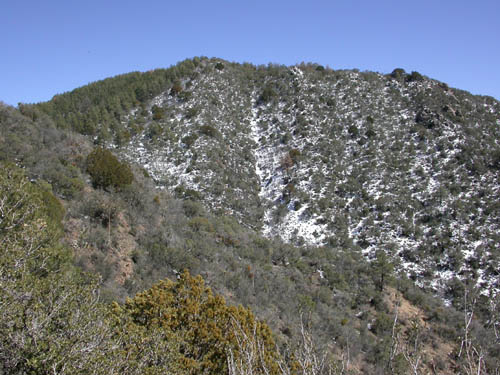
This photo shows an excellent interspersion of habitat types. The ponderosa pine forest in the upper left of the photo is supplemented by the brushy hillside. This kind of diversity of plants and structure is great for deer. Coues deer, like all white-tailed deer, spend a lot of time in edges where different types of habitats meet.
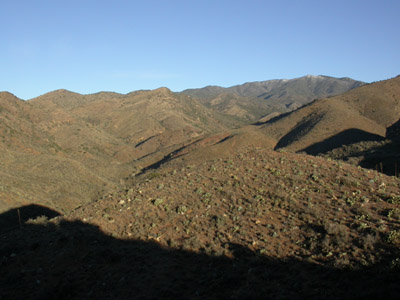
Coues deer are amazingly adaptable, they can occupy the ponderosa pine forest shown above or the very dry and more open habitat shown to the right.
Coues Life Stages
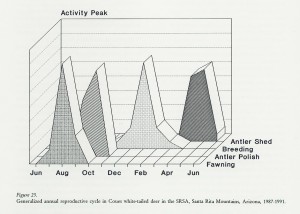
This graphic shows the peaks of activity for several of the life stages of Coues whitetail. Data and graphic are from the Arizona Game and Fish publication entitled "General Ecology of the Coues White-tailed Deer in the Santa Rita Mountains". Click on image to see larger view. Read the sections below for more detail about the life stages of Coues deer.
Breeding
The breeding season for the Coues deer is about 6-8 weeks later than northern or eastern whitetail. Breeding generally occurs from December to February with the peak usually in January. Some breeding activity can occur in November and some even as late as March. In November, bucks are generally found in small herds and can be seen sparring to establish dominance for the upcoming breeding season. These sparring matches are generally very short-lived and mild. They are much less dramatic than the spectacular battles that can occur during the rut. Bucks spend the breeding season searching for does in estrus (those ready to breed). Females are receptive to breeding for only 2-3 days. Females that are not bred in their first estrus cycle may be bred during their next cycle about 26 days later. Bucks can be very aggressive toward does during the breeding season. I have seen them chase a doe in a frantic effort to keep them from running away. They herd the doe much like a horse herds a calf or a sheepdog herds sheep, not allowing them to escape. If there are other bucks present around the doe, the dominant buck will usually be closest to the doe and force the other bucks to stay in the periphery. Bucks are most vulnerable to hunters during the rutting period because they are much more active throughout the day and rather careless in their single-minded pursuit of females.
Reproduction is highly influenced by the nutritional condition of bucks and does. Bucks that do not receive adequate nutrition can have delayed antler development which can lead to an extended rut period. Similarly, does in poor condition can have delayed cycles which can result in later fawning dates. Smith (1984) found that in a drought year in Arizona the average Coues fawning date was in the third week in August. Whereas in a year following several years of exceptional rainfall, the average fawning date was 2 weeks earlier. This 2 week difference in breeding activity has been documented in other whitetail subspecies for does on a nutritious diet compared to a substandard diet (Verme 1965). Smith (1984) also found that in years of poor food production, young Coues does (< 3 yrs old) may not breed at all and although the older does may still produce fawns, they have fewer of them (singles vs. twins). I have not seen any documentation in the literature that Coues deer can have triplets, but I have seen a Coues doe with three fawns in Arizona, which I presume were all her fawns. The fawns were of identical size and condition and were all following the one doe. It could be that she "adopted" a fawn from another doe that was killed, but that is probably less likely than her having had triplets. Production of triplets has been documented in other subspecies of whitetail.
Antler Cycle
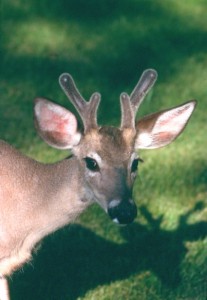
Coues buck in velvet. Photo courtesy of Wade Sherbrooke, Southwestern Research Station, Portal, Arizona.
Antlers are made of the fastest growing bone in the animal kingdom. Antlers are grown and shed annually, which in itself is amazing. In addition, generally, each year a deer’s antlers will grow larger than in the previous year. The annual cycle of antler development is primarily controlled by hormones produced in the pituitary gland and testes. Increasing daylength stimulates the pituitary gland to secrete substances that cause antler growth to start. Antlers receive the nutrients needed for growth through a fur covered skin (called velvet) covering the antlers. During this velvet period, the antlers are very sensitive to damage. If a buck injures his antler during this time, it will generally cause abnormal antler growth in the form of non-typical tines or bumps. These abnormalities may continue to be seen through each subsequent year’s antlers. In addition, it has been shown that in antler producing cervids (deer, elk) that an injury to the body will sometimes cause abnormal antler growth on the opposite side. For example if an elk injures his front right leg, the antler growing on his left side may become deformed. Later, the pituitary gland also secretes gonadotropin which causes the testes to enlarge. As the testes enlarge they produce an abundance of androgen which inhibits the pituitary antler-growth hormone, resulting in the stoppage of antler growth and the drying of the velvet covering on the antler. Antlers are eventually shed as changes in hormones cause the decalcification in the pedicle (the living bony growth on the frontal bone of the skull to which the antlers are attached).
Just as the breeding season for Coues is 6-8 weeks later than that for other subspecies of whitetail, the antler cycle is similarly delayed. For Coues deer, antler growth happens from June-September. During that time, the antlers are covered with “velvet”. After the buck has completed antler growth, the velvet dries up and is rubbed off (antler polish). In Arizona, Coues deer typically polish their antlers from late September to mid-October. Originally the antlers are white but become stained brownish from blood in the velvet and from the juices in the trees and bushes that the buck rubs his antlers against. Antlers are then used during the breeding season to secure mates through displays and fighting with other bucks. After the breeding season, hormonal changes cause the antlers to drop off. In Arizona, that antler drop typically occurs in April and May. Growth of the new antler begins shortly after antler cast.
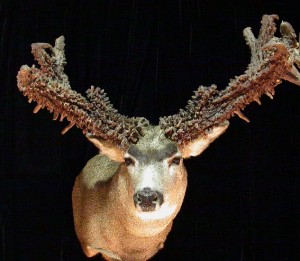
This is a picture of a mule deer buck, but I am using it to show what can happen with abnormal hormone production. Most likely his testicles were injured in some way so that he did not have the full range of hormone cycling. This buck never shed his antlers and the antlers stayed covered in velvet (velvet has been removed in photo above). The antlers grew year-round but in a very abnormal fashion. The antlers never solidified and they are very light, like balsa wood. This buck is one of the largest "cactus" bucks ever and he probably grew those antlers for 8-10 years before being shot by Ozzie Washburn in Chama, New Mexico. This buck is in the Roger Selner trophy deer collection which travels around to many of the hunting shows throughout the country. Photo by A. Moors.
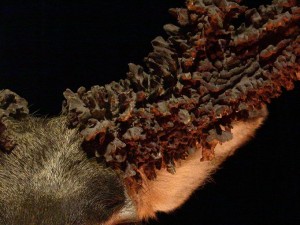
This is a closeup of that buck's antlers. Photo by A. Moors.
Fawning
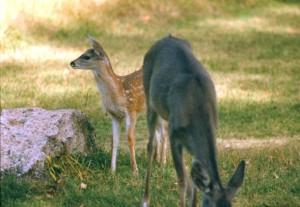
Coues doe and fawn. Photo courtesy of Wade Sherbrooke, Southwestern Research Station, Portal, Arizona.
Does that become pregnant will give birth to fawn(s) about 180-200 days later. Yearlings tend to give birth to single fawns while older does generally give birth to twins. Nutritional condition of the does and bucks influences by the timing of fawn drop and number of young produced (see discussion of this in the breeding section above). Most fawns are born in July and August. Fawns will weigh between 4-6 pounds at birth and nurse for two to three months. Fawns can eat some vegetation even while still dependent on the mother’s milk during the first month. In Arizona, nursing tends to occur between 0800-1000 and 1500-1800 hours. Fawns have spots on their coats for about the first two months of their lives. Fawns will stay with their mother until she drives them off, which usually happens just before she gives birth again the following year.
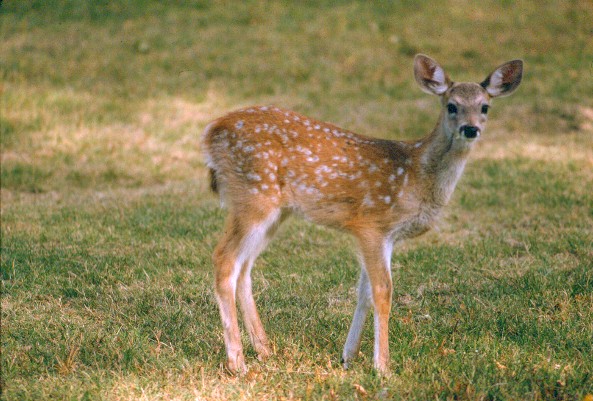
Coues fawn still showing spots in coat. Photo courtesy of Wade Sherbrooke, Southwestern Research Station, Portal, Arizona.
Shot Placement
Shot Placement
The information on this page is taken with permission from Craig Boddington’s excellent book “Shots at Big Game: How to shoot a rifle accurately under hunting conditions” published by Safari Press, Inc. Illustrations by Stuart Funk. Click on images to see a larger version.
Shot placement on a broadside deer is simple, but deer don’t often cooperate by standing just right. You’re more likely to get a quartering shot of some kind. On animals quartering away, try to locate the off-side front leg, and follow its line up to the chest area to find your aiming point. You need to visualize where the vitals lie from any angle, and plan your shot accordingly. On strongly quartering-away shots, your bullet may actually enter the deer’s body quite far back. On deer quartering toward you, keep your eyes on the on-shoulder; that one protects the chest area that your bullet must reach.
The problem with wind isn’t really that it has an effect — it’s in reading it and figuring just how much effect it will have. Winds at a 45-degree angle cause half the drift of a 90-degree crosswind, while headwinds and tailwinds have no effect at all. But is the wind at the target the same as where you are? How can you tell? You can read the wind carefully, but it comes down to a best guess.
It doesn’t matter whether the angle is uphill or downhill – the effect is the same. Your trajectory will essentially follow the trajectory curve of a bullet fired at the horizontal distance to your target.
Successful shooting of running game with a rifle isn’t materially different from hitting flying game with a shotgun. It’s essential that you keep the rifle barrel moving, establish your lead, swing with the target, and make certain that you fire with the barrel moving, following through afterward by continuing your swing.
Hunting Strategies
Weapon caliber
The Coues deer is a small whitetail (a good buck might only weigh 80-90 lbs.), for which small caliber weapons can be appropriate. I use a .270 to hunt for Coues, but you could even go with a smaller caliber weapon like a .22-.250 or .243. Many people use 7mm mags. What you want is a very flat shooting rifle that will allow you to become proficient at long-range shooting (250-400 yards).
As many guides will tell you, they want clients that are able to shot long distances because the bucks they spot may be far across a canyon. And quietly stalking to that far side of the canyon may be impossible due to the rocky soil and thick brush that is found in Coues country. Shot placement is very important to making a clean kill. Click on the “Shot Placement” button on the left to learn more about a well-placed shot.
Spot and Stalk
Most people who hunt Coues use the “Spot and Stalk” method. This method is ideal for our open landscapes in the West. To effectively spot Coues whitetail you will want to have premium optics. For years I hunted with cheap 7×35 binoculars, and although I was successful, I recommend that you buy the best binoculars (glass) you can afford. Several years ago, I upgraded to Zeiss 10×40’s which have made spotting deer much easier. Some people prefer to go with even more powerful binoculars, such as 15×60. That magnification is outstanding for spotting pieces of deer through foliage. But they are heavy to carry and most Coues hunters opt not to carry such large optics. The best binoculars and spotting scopes are made by Zeiss, Leica, and Swarovski. These high-end optics are superior in the light-gathering and contrasting ability. In low light situations, I can see deer in my binoculars when I can’t see them with my naked eye – it’s as if the binoculars turn on some extra lights. If you are looking to buy some new optics, please check one of our sponsors, Camera Land. They carry an excellent variety of binoculars and spotting scopes.
To use the “Spot and Stalk” method, find a high point in some good Coues habitat, sit down and use your binoculars to search the terrain for deer. The key to finding Coues is to GLASS, GLASS, GLASS. Several times I have been out hunting somewhere and seen some hunters drive up, jump out and quickly scan a canyon with binoculars. After about 10 minutes of searching, they are convinced that there are no bucks and they leave. Meanwhile, because I have been there glassing longer, I have found deer in that canyon that they missed. The old rule of thumb of that you should “wear the seat of your pants out before your boots” is very applicable to Coues hunting. I recommend sitting in one place for several hours and searching continuously, even going over and over the same brushy hillside. Coues tend to move slowly and are amazingly good at hiding behind the smallest amount of vegetation. A slight change in position can make a deer visible or invisible, which is why scanning the same areas several times is a really good way to find deer.
A view through a spotting scope. Can you find the two deer in the photo above? Click on image to see larger version. Photo taken by A. Moors. (It is extremely difficult to see the deer, so if you have given up trying, click here to see them)
After you get a good pair of binoculars, the next piece of equipment you will want is a small, portable tripod. Using a tripod to hold your binoculars tremendously boosts your ability to spot deer. The tripod allows the binoculars to remain completely steady which makes detecting movement in your field of vision much easier. I used to glass just by bracing my elbows on my knees and although that is one way to provide some stability to your binoculars, it is not the best. Without a doubt, using a tripod will make you a far better glasser.
There are many manufacturers that make portable tripods. You can look over some tripods in the CouesWhitetail.com store. The tripod I use is one my husband bought for his camera at a yard sale and I haven’t been able to find it for sale anywhere. It was made in Japan and says “Minette” on it, which I assume to be the company. It weighs a little over a pound (20 ounces) and extends to 40 inches tall. Folded up, it is only 11 inches long. Some binoculars (like my Zeiss) do not have a place to screw them into a tripod. I use an attachment that attaches to the binoculars with velcro straps and has a sturdy base that can be screwed onto my tripod. Tripods and attachments can get very high tech and very expensive. What you want is something that is sturdy, but is light enough so that you will be willing to carry it with you everywhere you hunt.
My setup for glassing. The next few pictures show the individual components of the setup. Photo by S. Wesch. The three parts of my glassing setup: the tripod, the binoculars and the attachment for the binoculars. Photo by A. Moors.
Tripod shown in folded up position. The head of the tripod has a standard screw (in center of red platform) to attach optics to the tripod. Many binoculars and spotting scopes have the threading to be screwed directly on to the tripod. If your optics don’t have a place for a screw, you can purchase an attachment like the one shown below. Photos by A. Moors.
This attachment screws onto the tripod and attaches to the binoculars using velcro straps. Photo below shows the binoculars in the attachment. Photos by A. Moors.
When you are glassing, get comfortable. Get a seat pad of some kind and sit so your neck and back won’t get too strained. The more comfortable you are, the longer you can glass and the more deer you will see. I use a seat pad from Crooked Horn Outfitters. It’s great! It’s lightweight, made of saddlecloth so it can handle field conditions and it’s comfortable. It insulates you from the rock or ground that you are sitting on so you stay warmer as well. I also use the master guide daypack from Crooked Horn. I can pack out a boned-out Coues in one of those packs, along with my hunting gear. It’s a great product!
To glass effectively, you can use a couple of methods. One is to look over the habitat and decide where the deer are most likely to be at that time of day and glass those areas the most. That is what I generally do. Look at the lay of the land and think about how a deer would use the landscape. Where is the best food? Think about which plants are green and growing at the time. Where will the deer feel secure? Is there a water source nearby? Glassing closer to the water (say within a 1/2 mile) is more productive than glassing farther from the water. Is it early morning? The deer are more likely to be out in open areas. Is it late morning and getting hot out? Glass the thick brush and other bedding areas. The longer you hunt Coues, the better you will get at predicting where they will be at any given time.
If you don’t have a feel for where the deer would be, or the habitat is fairly monotypic such that they could be anywhere, use a systematic approach to glassing. Say you are glassing the hillside in the photo below.
You want to pick apart that hill systematically with your binoculars. Start at the top left corner and work your way across the slope to the top right. Then adjust your tripod so that you are viewing the next “row” down. Glass back to the left side. Do that same systematic glassing until you have covered the whole slope. If you haven’t seen anything yet you think it’s a good place for a deer to be, then start over. Glass the same areas several times. You don’t always see the deer the first time through. They may be behind a bush or just have been standing perfectly still and so your eye didn’t pick them up. Give the deer a chance to show themselves to you. Look for pieces of a deer. Maybe you will see the line of a deer’s back as it feeds with it’s head down behind a bush (as in the spotting scope photo earlier on this page). Maybe you will just see part of a leg. The more experience you have glassing, the more these small pieces of a deer “jump out” at you as you look at them.
Many people glass too fast. If you search too fast, you won’t find these tiny deer or you will only see the deer when they are fully in the open. You will miss the deer that are partly hidden. It’s almost impossible to glass too slowly. Force yourself to slow down and you will see more deer.
When you glass, let you eyes adjust to each new field of view. Let them focus for several seconds and search around in your field of view. On a brushy hillside like that one above, you will really have to concentrate to pick up a Coues deer. Sometimes in order to force myself to concentrate better and slow down my glassing, I will imagine that I am actually walking around in that field of view. I pretend as if I am actually on that slope searching around and peering through each bush. Doing that forces me to search more effectively. Look behind the bushes, search everywhere for any hint of a deer. When you have thoroughly searched in your field of view, move the binoculars over so that you are covering some new ground, but can still see about half of the old field of view. That method gives you extra coverage of each spot and will increase your odds of seeing deer. If the country is fairly open you don’t have to overlap field’s of view so much.
Once you spot a deer, take note of where you are looking BEFORE you pull you eyes away from the binoculars. Mark the spot in your mind so that you can find the deer again. Most likely you will want to put a spotting scope up on the tripod and get a better look at the deer. To find the deer again you will have to know where the spot is that you are looking at through the binoculars. Many people have trouble with this, but with practice you will get better. Once you have looked over the unique vegetation around the deer in your binocular, take a look at the slope with your naked eye. Can you spot the same vegetation so that you know exactly where the deer is? If not, get back in the binoculars and look some more. Are there three junipers and a yucca lined up? Is there a unique prickly pear near the deer? Maybe the deer is 50 yards downhill of a big white rock. Look for something unique that will help you zero in on the buck with your scope. I have been out with several people who have seen deer, but then they take their binos down before marking the spot and then they can’t find the deer again. This is especially a problem if you are not using a tripod, since you can’t just leave the binoculars set on the deer while you look with your naked eye. Whatever method you use, you don’t want to loose track of a deer you may have spent hours finding.
Most serious Coues deer hunters also carry a high quality spotting scope with them. A spotting scope will increase the weight of your pack that you are carrying all day, but it will save you some energy by allowing you to evaluate bucks without hiking over to them. If you are hunting for a large Coues, carry a scope with you. If you aren’t so picky about which buck you get, then perhaps the extra weight won’t be worth it. I carry the newly released Zeiss Diascope 65T*FL. These new, smaller, lighter scopes are great for packing. Leica has also come out with light weight scope. Having a lighter spotting scope will allow you to use a smaller tripod. I recommend that you go to a sports store that carries high-end scopes and have them set up several scopes for you to look through. That way you can pick that one that you like the best.
My Zeiss Diascope 65T*FL. They sell an angled eyepiece, but I prefer the straight one. This eyepiece is a variable one that goes from 15x to 45x. It will also fit on the larger versions of this scope and then it will give you 45x-60x power.
Planning a stalk takes some good knowledge of the lay of the land. How will you get to that ridge the buck is on? Plan a path that allows you to get over there without the buck seeing or hearing you. That can be difficult in the rocky and open landscapes in Coues country. Use the topography to your advantage. A hillside can block the noise of you approaching if the buck is on the other side. Then you can cover ground much more quickly.
How close should you get? Well, that depends on the range you are comfortable shooting at. I always try and get as close as I can to my target. Some people think nothing of taking a 400 yard shot, but that isn’t what I prefer. I try and get within 200 yards. But really it’s a matter of your comfort level, which is dependent on how well you know your ballistics and your shooting ability.
Still Hunting
Still hunting is a very difficult method for most people to master. It requires extreme patience since the hunter must move very, VERY, slowly through the landscape. It also requires a hunter to use all his senses to figure out what is happening around him. In still hunting, a hunter may take 30 minutes to move 50 yards or less, depending on how thick the vegetation is. This method can be successful when deer density is fairly high or in an area you happen to know is holding deer at the time. In Arizona, I have used still hunting to sneak up on deer in juniper or oak flats or along fairly flat drainages. It can be especially useful to the bowhunter who needs to get into close range for a shot. You may end up using still hunting as the way to finish your spot and stalk hunt. If you spot a buck far away and watch it go into an area where you think he will bed, but you aren’t able to find him through binoculars, you can hike over to that area and then slowly still hunt it – walking through the area looking for the deer. You will be looking for just pieces of the deer. You may only see an ear tip, or a tail, or just the line of the leg. Walking quietly in Coues country can be very challenging. You can walk in your socks (take a really thick extra pair to keep rocks and cactus from stabbing you) or use commercially made “stalkers” (they fit over your boots) to soften the sound of your footsteps.
Hunting from a Tree Stand or Ground Blind
As with still hunting, hunting from a stand or blind takes a lot of patience. Being comfortable is a key to making this method work because if you are comfortable (not freezing your butt off!) you won’t move around so much. A tree stand or ground blind is placed in an area where the hunter expects deer to come. In Coues country, this is typically a water hole. But they can also be placed along trails or saddles where you expect deer to move through. You want the stand to be downwind of where you expect the deer to be. In a tree stand, you don’t have to worry so much about total concealment as you do in a ground blind. A tree stand gives you an advantage over the deer because they don’t look for predators to come out of the trees after them. Although that is not to say that deer don’t learn about hunters in tree stands and learn to avoid them. But you have an advantage and assuming you don’t “teach” the deer about your tree stand by having a lot of scent around it or by allowing them to see or hear your movement in the stand.
Personally, I prefer ground blinds. I am just more comfortable there. I also like that you don’t have to haul anything in to put up in a tree. Generally you can make a ground blind out of the scattered limbs and bushes around a waterhole. If you know for sure which way the deer will come in, you can build your blind so that you are covered from view only from that direction. However, you are likely to be more successful if you totally surround yourself with vegetation, in the off chance that the deer comes in from a direction you are not expecting. It is also important to have vegetation behind you so that your profile is broken up behind you as well as in front of you. This makes is doubly hard for a deer to see you. It may help if you make the blind ahead of time and let it “sit” for several days. That way the deer will get used to it and any scent you left while making the blind has a chance to dissipate.
You will want to have full camoflauge on, including head and hands. You also don’t want anything metal shining through your stand when the sun hits it, so you may want to use camoflauge tape on your gun, bow or other metal objects. And you want to be scent free, which means using human scent eliminator sprays or soaps or something like a Scent-lok suit that locks in odors.
Rattling
I should start off by saying I have never used this method to hunt deer. However, I am dying to try it and will do so this January. I killed a buck this November and will be using his antlers to rattle up some other bucks – or at least I will try to!
With rattling you want to imitate the sound of deer sparring or fighting. This method can be used to draw deer to you for close range hunting. As with calling in any kind of game, you want to be set up in an area where they can’t see you or smell you when they come in. You will probably want some kind of ground blind to conceal your movements. Deer are most likely to come in from downwind so they can “nose around” the situation before they expose themselves. If you set up near an opening, you may be able to force the deer to come in from upwind. They may prefer coming in from upwind rather than exposing themselves in the opening. My guess is that rattling for a minute or two, followed by listening for 5-10 minutes might make a good sequence. Repeat the sequence for an hour and see what happens. You may want to add some doe bleats or buck grunts as well as ground scraping noises for added realism. Their are electronic deer callers that can make all these noises for you. Check out the one made by Extreme Callers.
In the pre-rut (November-December for Coues), bucks are sparring to establish dominance. These fights are mild and short-lived. In contrast, fighting during the peak of the rut in January can be far more intense. So if you are trying rattling, think about the time of year and imitate either the mild sparring sounds of the pre-rut or the hard edged fighting of the rut.
If the buck is already with some does, he is less likely to leave them and come check out the fight. Rattling can also be another way to complete a spot and stalk hunt. If you spot a buck, but he moves into cover where you can’t find him, hike over there and set up. You may be able to lure him out to you by rattling.
Got some old antlers around? Give rattling a try, it might just draw in that buck you have been trying to get.
General description, taxonomy, evolution, and genetics
Description
If someone should conduct a beauty contest among the game animals of the Southwest, I have no doubt the Arizona whitetail would win hands down. A big buck mule deer, with its massive antlers and blocky build is a magnificent sight. Likewise a great desert ram or lordly bull elk. But the Arizona whitetail is an exquisitely lovely thing. ~Jack O’Connor
The Coues white-tailed deer (Odocoileus virginianus couesi) is one of the smallest deer in America. Coues deer stand around 28-32 inches tall at the shoulder and measure about 56 inches (1426 mm) from head to tail. A large field-dressed buck will rarely exceed 80-90 lbs. (although some can exceed 100 pounds) and a doe tends to weigh about 65 lbs. Hoffmeister (1986) reported the average weight of 7 males from the Chiricahua Mtns. in Arizona as 83.5 lbs (37.65 kg); of 19 females as 67.3 lbs. (30.53 kg). Raught (1967) reported that bucks in New Mexico averaged 85-90 lbs (39-41 kg) and females averaged 65 lbs. (29 kg). In contrast, a good-sized field-dressed Eastern Whitetail buck will weigh approximately 200 lbs. (90.91 kg).
You can see in the photos below the size of a Coues deer buck relative to the size of a man. Both these are large, mature bucks. The one on the left was exceptionally large bodied. It probably weighed 115-120 lbs. whole. At the meat locker it weighed 79 lbs. and it had no head, legs, internal organs or skin on it. Photos by A. Moors and M. Hanson.
The Coues deer varies in color from a grayish coat in winter to a more reddish-brown color in the summer. Fawns are born with numerous white spots on their coat. Those spots generally disappear after about 2 months. Coues deer have the classic white circles around its muzzle and eyes seen on other subspecies of whitetail. However, Coues tend not to have such a pronounced white throat patch as do whitetail in the East and to the North. The tail of the Coues deer is generally brown with a border of white on the topside and completely white on the underside. This is in contrast to a mule deer which has white on the topside of the tail. Tail color can vary geographically. The topside of a Coues tail can be grayish, reddish brown, or black (see photos below).
The illustrations above show the tail pattern variation in Coues deer and mule deer in Arizona. Graphics provided with permission from Dr. Donald Hoffmeister and were taken from his book “Mammals of Arizona” published by University of Arizona Press. Click on pictures to see larger version. Note the narrow, rope-like white tail of the mule deer in comparison to the wide, colored tail of the Coues.
The photo to the left shows three Coues spike bucks with three different tail colors. Photo taken near Globe, Arizona on December 2, 2002 by Amanda Moors. Click on image to see larger version.
The nice 3 point buck in the photo to the right has a two-toned colored tail. It is reddish-brown on the upper half of the tail and black on the lower half. Photo taken Dec. 22, 2002 by A. Moors in the Roosevelt Lake area in Arizona. Click on image to see larger version.
How do you tell a Coues Deer from a Mule Deer?
In most of the Coues whitetail range, the other common species of deer is the mule deer (Odocoileus hemionus). Although there are some similarities in looks between these two species, it is generally easy to distinguish between them.
The tail is the easiest way to distinguish these two deer species (see graphic below). Coues deer also have a much wider tail that is white underneath, but not ontop. The tail of the mule deer is much skinnier, very rope-like, and is white with a black tip. When Coues deer are excited, as when fleeing a person or predator, they will raise their tail. This prominently displays the white under the tail and is commonly referred to as “flagging”. The mule deer will not raise its tail in that manner.
In addition to the tail flagging, you can also tell these deer apart by other differences in their behavior. White-tailed deer generally live in small groups of 2-5, not larger herds like mule deer. White-tailed deer and mule deer have different predator avoidance strategies. When mule deer are fleeing a predator they will use a unique gait called stotting. Stotting is the gait where they bounce stiff-legged on all four legs at the same time. Whitetails will not do this. They will leap or trot away from danger.
Coues deer have a much smaller metatarsal gland found on the outside of the hind leg (not the tarsal gland on the inside of the leg –see graphic below). The gland is covered by white hairs in the Coues, but by buffy or brown hairs in the mule deer.
This figure is provided courtesy of Dr. Donald Hoffmeister and is taken with permission from his excellent book “Mammals of Arizona” published by the University of Arizona Press in 1986. It shows the differences in metatarsal gland (see arrows) and tail of the white-tailed deer compared to the mule deer.
Coues deer have the classic white “halos” around their eyes and muzzle. Mule deer will have quite a bit more white on their faces, not just encircling the eyes and nose. Mule deer also have more black coloration on their foreheads. These facial differences are very useful to help identify deer that are facing you and you can’t see their tails.
This photo shows the white halos on a Coues Whitetail’s face. Sorry the photo isn’t really in great focus, but you can see the white rings fairly well. Photo by A. Moors.
Coues whitetail, like other whitetail, have antlers that have the tines coming directly off the main bean. In contrast, a mule deer has branching of the antlers such that some tines come off other tines in a regular forked pattern. A young Coues that has just two points (a forkhorn) on its antlers will look very much like it has the branching pattern of a mule deer. Keep that in mind when using this feature to identify deer.
Mule Deer Skull Coues Deer Skull
The photos above show the differences in antler branching patterns of Mule Deer and Coues Deer. Note the branching of the mule deer antlers versus the tines coming off the main beam on the Coues. The mule deer photo is courtesy of Dr. Donald Hoffmeister, from his book “Mammals of Arizona”. The Coues deer photo was taken by Amanda Moors.
Taxonomy/genetics/evolution
Coues white-tailed deer (Odocoileus virginianus couesi) is one of about 35 subspecies of white-tailed deer. The Coues deer is a member of the order of animals called Artiodactyla, which is a group of hoofed mammals that use their third and fourth toe as their main support when walking. This group is also referred to as even-toed ungulates. Elk, javelina, antelope, bison, and bighorn sheep are also members of this order. Deer belong to the family Cervidae, whose members are characterized by, among other things, having antlers that are shed annually and a four chambered stomach. White-tailed deer are members of the genus Odocoileus and the species name virginianus. The subspecies of Coues whitetail is denoted by having couesi added to the genus and species names.
In terms of evolution, the white-tailed deer (Odocoileus virginianus) is the oldest deer species, whereas the mule deer (Odocoileus hemionus) is the youngest deer species. The white-tailed deer shows up in the fossil record for North America over 3 million years ago. The mule deer seems to be a species that only developed after the massive mega-faunal extinctions about 12,500 to 7,000 years ago. For more information about the evolution of deer, I highly recommend a book by Dr. Valerius Geist called “Deer of the World: Their Evolution, Behavior, and Ecology”.
Roy Lopez with Northern Arizona University is currently studying the genetics of Coues whitetail in Arizona. I hope to post his preliminary results as soon as they are available. DNA analysis can tells us, among other things, if deer in the Chiricahuas ever travel to the Galiuros or other mountain ranges. Or if those deer are reproductively isolated over the long term from the rest of the “sky islands” in the southeastern part of AZ. If you have antlers or tissue from deer harvested in Arizona game management units 21, 22, 23, 24a, 24b, 27/28 and/or 30b, please email Roy Lopez and find out how to get the sample to him. The more samples he gets, the more reliable the data. If you are a shed hunter and remember where you picked up those sheds, give Roy a shout and see if you can help him out. He can get a sample from the bone under the base of the antler.
2024 Coues Calendars are in!
Darren Freestone has put together another great Coues buck calendar for 2024! The calendar is a spiral-bound, heavy-stock, full-color wall calendar that you will enjoy looking at all year! Thank you Darren for putting this together for us! In addition to having great photos, the calendar has moon phases and dates when hunt applications are due in Arizona!
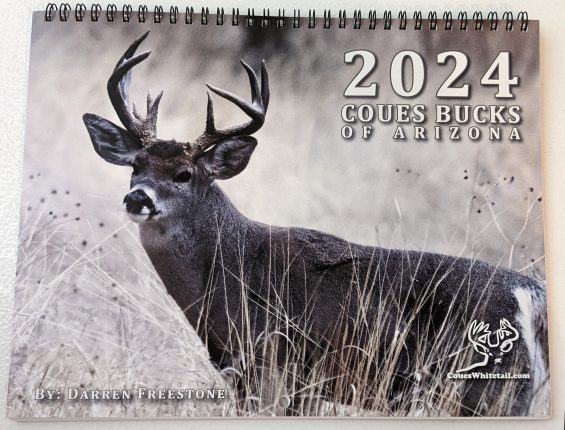
Buy your calendar today!
Women’s Javelina Hunting Camp 2021
Women’s Javelina Hunting Camp 2021
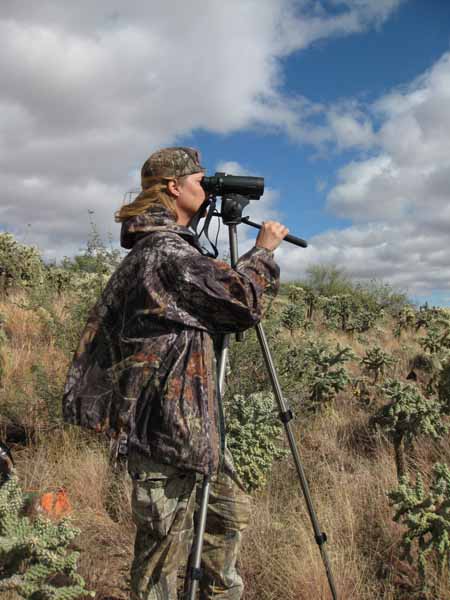
Unit 36A/B/C Adult Women’s Javelina Hunt Camp – February 11-14, 2021.(plan to arrive the afternoon/evening of the 11th if you can, or if you want to come earlier, let Kathy Greene tucsonhuntered@comcast.net)
Registration is required for this event. to register please visit : https://register-ed.com/events/view/160780
Are you a woman interested in learning how to hunt? Then this camp is for you!!
The goal of this free camp is to provide a safe, fun hunting experience for novice adult women hunters (18 and older). Experienced hunters (mentors) will be matched with novice women hunters (students). The novices will learn skills for hunting javelina. Many of these skills can be applied to hunting other game species. Legal methods of take for this hunt include archery, muzzleloader or handgun. Please be aware this hunt will involve hiking on uneven terrain and/or climbing of hills.
Learn more about javelina, how to hunt them, and some tasty recipes for cooking javelina at http://www.javelinahunter.com/
The AGFD has a short video about javelina. http://www.azgfd.gov/video/javelina.shtml
This camp is made possible through a grant from the Arizona Game and Fish Department and the support of the Arizona Chapter of the Safari Club International, Hunting Works for Arizona, CouesWhitetail.com, Arizona Outdoor Women, AZ Game and Fish Dept Tucson, East Valley Chapter of the NWTF, Pass it on Outdoor Mentors, and numerous outstanding volunteers.
Pre-registration is required! Students please register by visiting https://register-ed.com/events/view/160780 . Enrollment for this camp will be limited to 25 adult women hunters. Mentors, please contact Kathy Greene to let her know you want to help or go to this link to sign up as a mentor . There is no cost to attend the camp, however in order to secure a spot at this camp, you must pre-register and you must purchase an AGFD hunting license and javelina tag for the Handgun, Archery, Muzzleloader hunt in Arizona hunt units 36A, B, C (hunt numbers: 5077 (36A), 5078 (36B, best for using a bow) and 5079 (36C)). Need help figuring out how to get a tag? Call the Tucson AGFD office at 520-628-5376 or Dewane Tabbot at Mesa AGFD office and he will help you out: 480-981-9400. We will not save a space for you at this camp if you have not pre-registered. We need to get a good head count for this camp so that we can make sure we have enough mentors and meals for everyone. Having a required pre-registration will assist us with this. All food and coaching will be providing free of charge to all participants at this camp.
Please remember this hunt is geared toward teaching first-time hunters and novice hunters how to hunt. Since space is limited, we give preference to those with the least experience. We strive to provide a 1 to 1 student to mentor ratio, but we do not guarantee that. Students who have not previously attended the camp and those with the least experience will be given preference with regard to mentors. Those who have attended the camp multiple times or who already have significant experience hunting may be put on a waiting list and allowed to attend the camp if space is available. The focus of this camp is to recruit new hunters and give support to those still learning to hunt.
Questions?? email Kathy Greene tucsonhuntered@comcast.net
Need help figuring out how to get a tag? Call the Tucson AGFD office at 520-628-5376 or Call Dewane Tabbot at Mesa AGFD office and he will help you out: 480-981-9400.
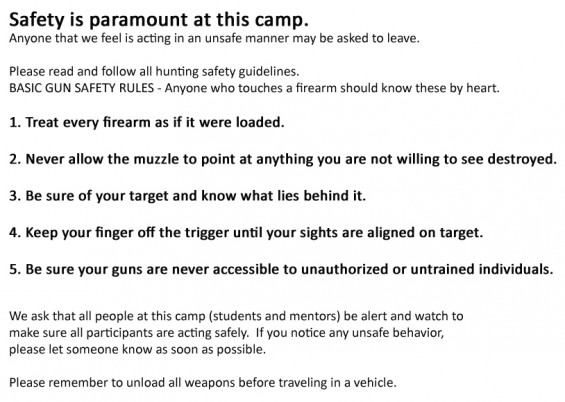
Anyone wishing to take a hunter education/safety course may find one here: http://www.azgfd.gov/i_e/edits/hunter_education.shtml There are several classes available that will be completed by the time this hunt comes around in February. You may also take the class online at your own pace. I highly recommend taking a hunter education class if you have not already (however, this is not required by adults attending this camp).
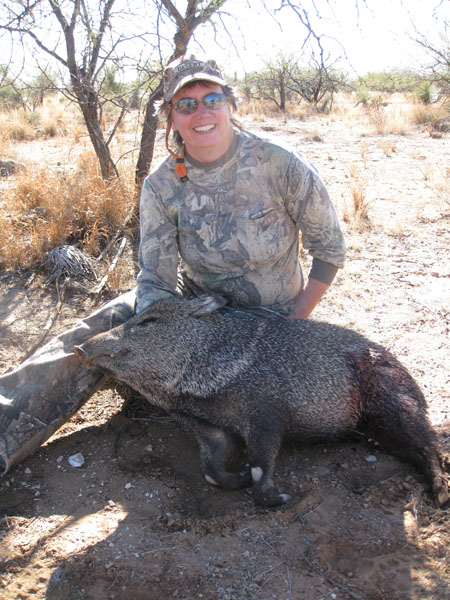
How to get a leftover tag for this hunt: Leftover hunt permit-tags can be obtained two ways. Beginning in late November, Game and Fish will accept applications by mail only in the same way as the regular drawing process. Then in early December, leftover tags are also available for purchase in person from any of the seven Arizona Game and Fish Department offices. A list of office locations is available at www.azgfd.gov/offices. Just drop by one of the AGFD offices and tell them what you want and they will get your squared away.
Please read the spring hunt regulations put out by AGFD
What is included at the camp: All your meals and drinks (non-alcoholic) will be provided. Every student that has a license and tag will be able to go out hunting with a mentor. We will strive for a 1:1 ratio of students:mentors, but we can’t guarantee that at this point.
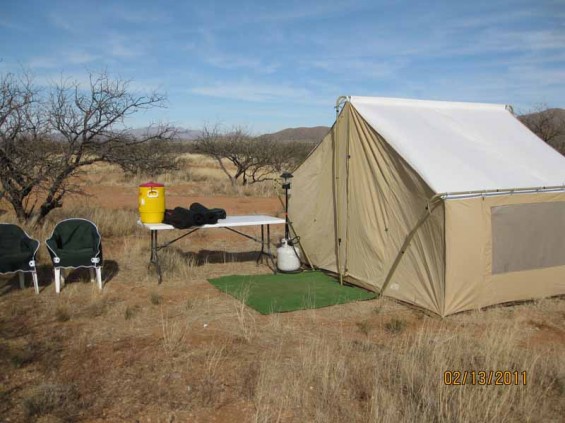
You may bring your own tents, trailers or RVs to camp in. If you need camping gear, contact Kathy Greene tucsonhuntered@comcast.net
Tentative Camp Schedule (you may show up at camp at anytime and leave whenever you need to, but please let Kathy know what day and time you plan to arrive and let her know when you leave)
Thursday – Feb. 11, 2021 – Arrive in the afternoon/evening to set up camp and get ready for the hunt the next morning. If you can arrive earlier in the day, you might be able to hunt since the season will be open. Please coordinate with Kathy if you plan to hunt on Thursday.
Dinner 6:30 to 8 pm
Friday – Feb 12, 2021 –
Breakfast – 6 am to 7 am Hunter Safety Talk – for those that missed this the night before
Morning hunt
Lunch – 11 am to 1 pm
Afternoon hunt
Dinner – 6:30-8:00 pm
Saturday – Feb 13, 2021
Breakfast – 6 am to 7 am
Morning hunt
Lunch – 11 am to 1 pm
Afternoon hunt
Dinner – 6:30-8:00 pm
Sunday – Feb 14, 2021
Breakfast – 6 am to 7 am
Morning hunt
Lunch – 11 am to 1 pm
Pack-up and head home or Afternoon hunt for those who wish to stay
What you need to bring:
Personal Items: clothing, toiletries, sunscreen, hats, gloves, etc. It will likely be freezing at night and the early mornings, so please bring warm clothes. A camera is nice for recording some memories. A flashlight or headlamp will be useful at camp and during the hunt. Good hiking boots are recommended. If you are a light sleeper, you may want to bring earplugs as there may be people who stay up later than others at camp. We will also have generators running at times.
Camping equipment – tent, sleeping bag, sleeping pad. If you need some camping equipment, please let Kathy know and we will see if we can find some to loan you. You will probably want to bring an ice chest in case you get a javelina and want to transport the meat and hide home.
Hunting Equipment — backpack, hunting clothes (camo is best), a weapon and ammunition (handgun, archery or muzzleloaders only), knife, binoculars. If you have a tripod for glassing, you will want to bring that too. A range finder is very helpful also for judging distance of the animals for a shot. You should also bring a gamebag, some large ziplock bags, and a cooler to put the meat in. You may also want to bring a pair of small rubber gloves to wear while cleaning the animal.
A Positive Attitude!! It is important that everyone come with a positive attitude and an open mind, ready to learn. We also ask that everyone be respectful and helpful to everyone attending this camp. We expect 50-60 people at this camp and so we ask that you go out of your way to maintain good relations with everyone. We want everyone to have a great time and a little courtesy will go along way.
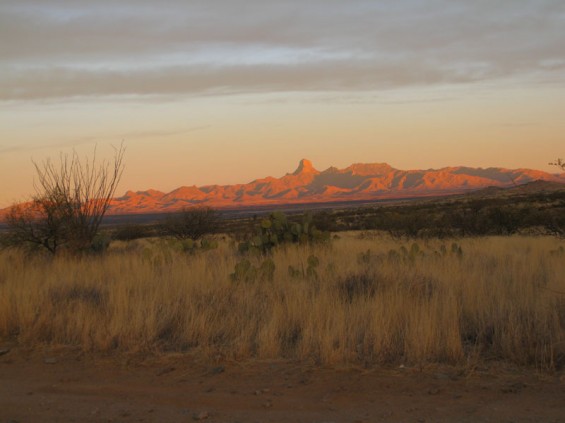
Photo of the Baboquivari Mountains
Photo of the Babaquivari Mountains.
Location of the camp:
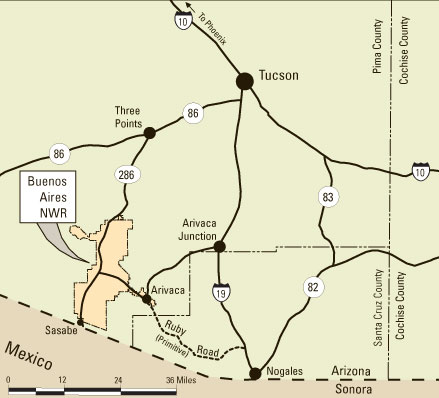
We will be camping on the beautiful Buenos Aires Wildlife Refuge. For more information about the refuge, visit their website:http://www.fws.gov/southwest/refuges/arizona/buenosaires/
There are special rules that apply when hunting and camping on the refuge. Javelina hunting is allowed on the refuge, but you may not hunt quail or some other species. We will be hunting on both US Forest Service Land as well as the Refuge, so different rules apply depending on the agency that oversees the land.
The Buenos Aires Wildlife Refuge has made a group campsite
here is where its located.
GPS location for
camp: N 31o 37.971’, W
111o 26.181’
Directions
Directions
from Tucson, AZ via the Freeway: From Tucson, drive south on I-19 to the
Arivaca exit (Exit 48) (about 33 miles from the I-10). At the stop sign
on the off ramp take a right (west) to the next stop sign, take another right
(north), and then take the first left road on to Arivaca Road. Drive west
to the town of Arivaca (about 23 miles). At the only gas pumps (see note
below) in Arivaca, drive through the town on what is now the Arivaca Sasabe
Road until a little past the cell tower on the left (south) side of the road
(8.1 miles). The second left (south) dirt road past the cell tower is the
entrance (N 31o 37.971’, W 111o 26.181’) to the most
direct route to the Women’s Javelina Camp. Drive down the dirt road until
you have reached the Camp.
Directions
from Tucson, AZ via Three Points: From Three Points (see note below), drive
south on highway 286 (also called S. Sasabe Road). Around mile marker 12,
turn left (east). Continue driving on the Arivaca Sasabe Road until a
little before the cell tower on the right (south) side of the road (3.7
miles). The second right (south) dirt road before reaching the cell tower
is the entrance (N 31o 37.971’, W 111o 26.181’) to the
most direct route to the Women’s Javelina Camp. Drive down the dirt road
until you have reached the Camp.
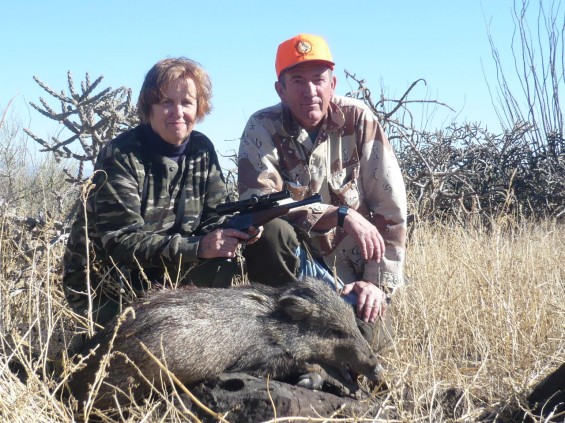
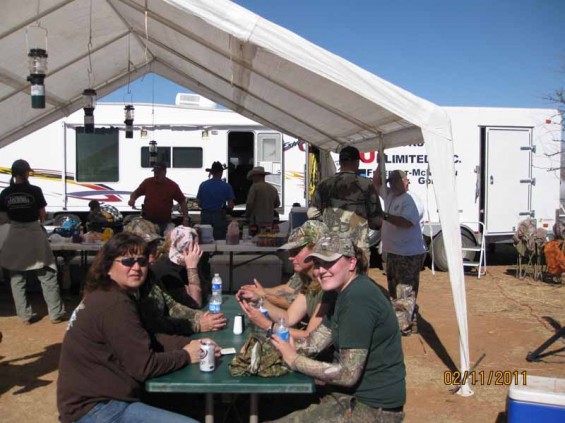
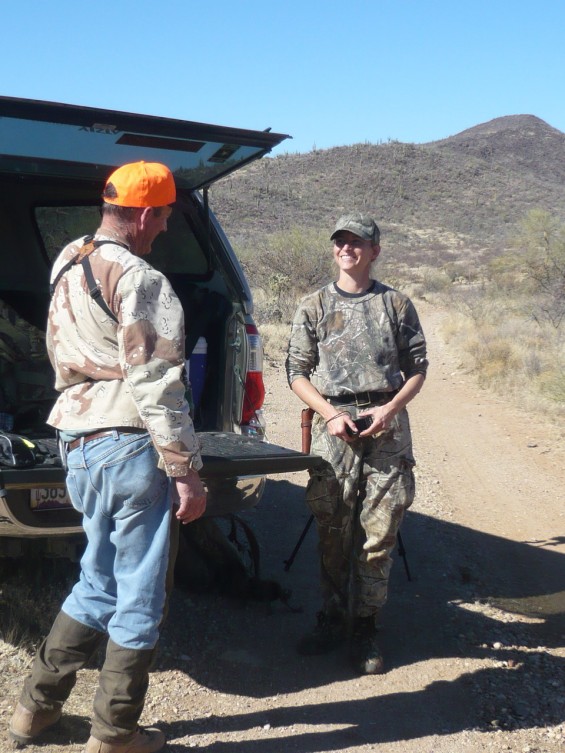
Welcome to AZ Field Optics as our newest sponsor!
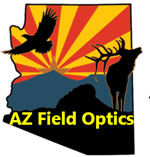
I am excited to introduce Arizona Field Optics to the CouesWhitetail.com community. AZ Field Optics is a great business that will really help those of you looking to purchase new optics for your hunts! AZ Field Optics was opened as a new business entity in August of 2017. However, Arizona Field Optics is owned and operated under the umbrella of Jay’s Bird Barn and Jay’s Bird Barn has been in business over 15 years. They have been selling optics since 2004 to the outdoor and hunting community. This is a business dedicated to providing GREAT customer service! I called and spoke with several of their customers and they told me, without exception, that they were blown away by the customer service provided to them. One customer told me how the store let him borrow a pair of Vortex 15×56 for a hunt. He used the binoculars on the hunt and loved them and so ended up buying them! Another customer told me that he had a hunt coming up in Mexico and a friend that was going with him broke his tripod just before the hunt. So he called Ryan (department manager) at AZ Field Optics and Ryan loaned him his personal tripod to take on that hunt in Mexico! Wow, that’s customer service!
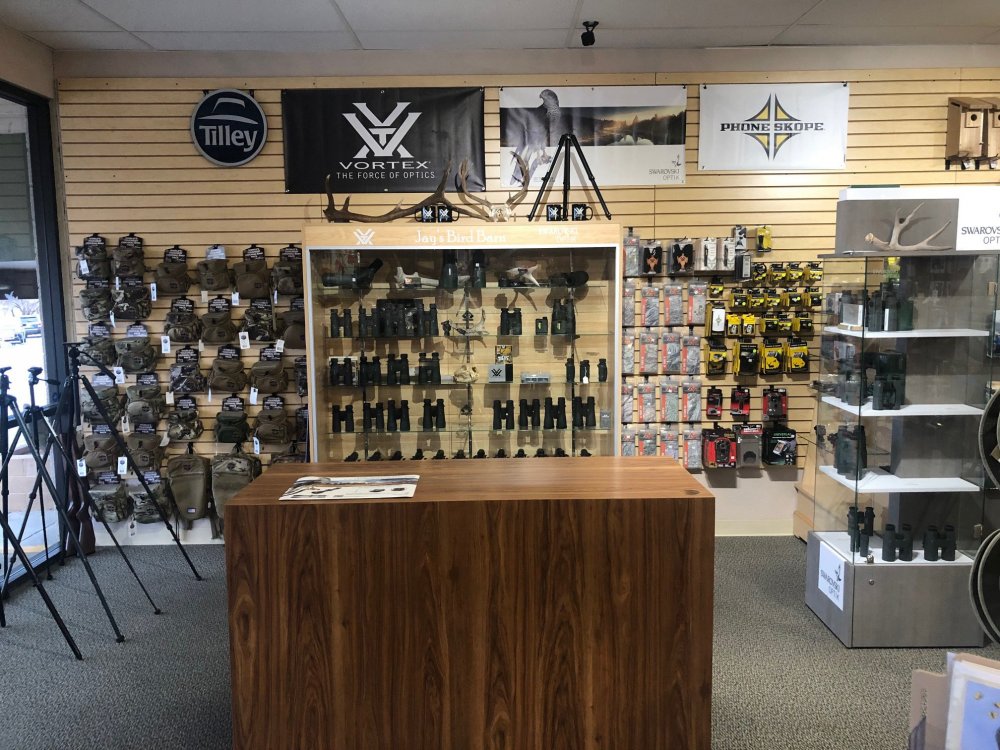
A great feature of this store is that you can go there and physically handle and compare any optic you are interested in. They have every Swarovski and Vortex binocular on hand almost all the time. So you can go and compare and contrast each binocular and find the one that is best for you. And they will allow you to borrow a pair to try on your hunt. They also carry a large assortment of their other products and have full access to the entire catalogue of Swarovski, Vortex and Kahles. They have invested in a large inventory and take pride in knowing our products.
Jay’s Bird Barn, the owner of Arizona Field Optics, has won awards on both a national and city basis—Best Retailer Award, and best small business award with the Prescott Chamber of Commerce. Since Arizona Field Optics is located inside Jay’s Bird Barn we get a lot of foot traffic, we had over 30,000 customers inside our store last year.
I asked them what their top 5 popular products were and they said : Swarovski Binoculars, 15×56 SLCs because we consider them the pinnacle of long range glassing in a bino, 8×32 ELs because they represent an extremely high quality optic in a nice lightweight package that is excellent for archers, Viper Line of Binoculars because the cost to performance ratio makes them a very nice buy for a lot of folks, Viper line of Riflescopes because there are a wide range of options and price points in that lineup, Vortex Razor 27-60×85 Spotter because you get a great scope for a price that most people can afford. Also, as a bonus “item”, we recently became a dealer for Outdoorsmans in an effort to better serve folks in this part of the state and their products have sold very well in the short amount of time we’ve carried them.
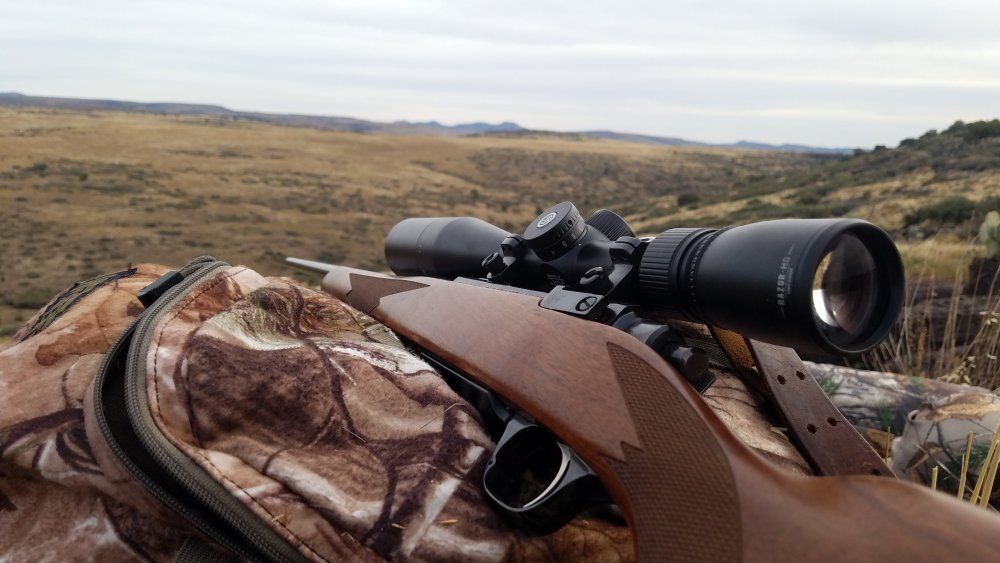
“We are a family owned business. We bend over backwards to take care of our customers. We have an excellent reputation in Central and Northern Arizona. We have amazing customers that keep coming back. We have a great website, but we would prefer to do business directly with the customer over the phone instead of them placing their orders electronically. Give us a call and we will work with you and get you exactly what you want. We know Arizona and the Southwest. We know the people, the places and the unique terrain and circumstances that make this such a wonderful yet challenging place to have fun outdoors.”
They also have an excellent Optics Referral Program. “If you buy either a scope, binocular, or tripod equipment from Arizona Field Optics you are automatically entered into our Referral Program. When you refer someone to us, and they buy optics from us, you get a 5% store credit on their purchase and you can use it on anything in the store. This program is unlimited in how much you can earn. You will get that same 5% on the first optics transaction of EVERY customer that is sent to us.”
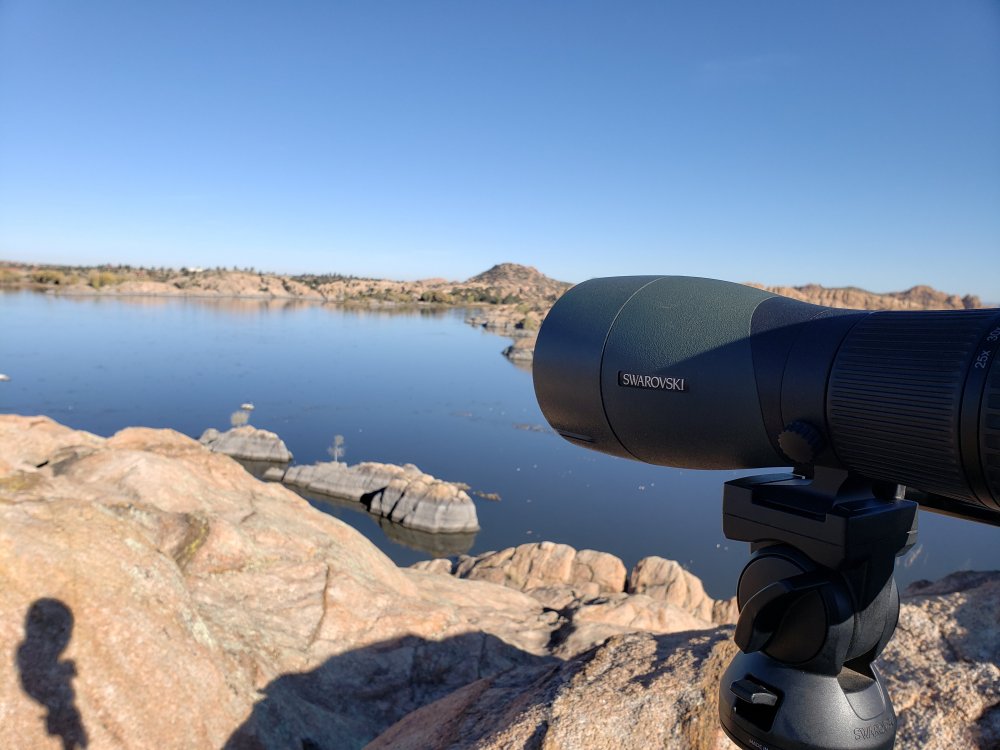
Arizona Field Optics is located at 1046 Willow Creek Road, Suite #105, Prescott, AZ 86301. Phone number is 928-778-1500. Arizona Field Optics is located inside of Jay’s Bird Barn in Prescott.
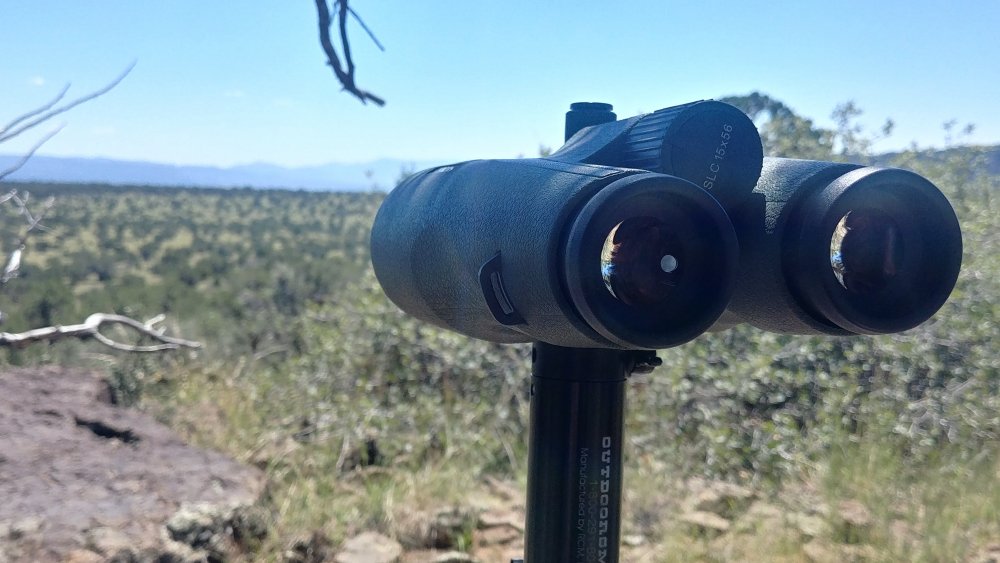
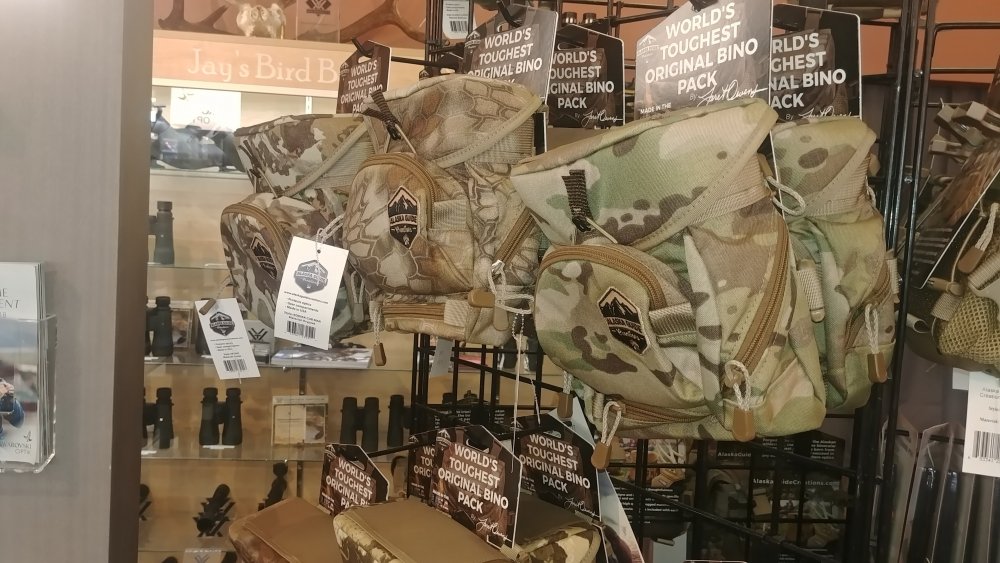
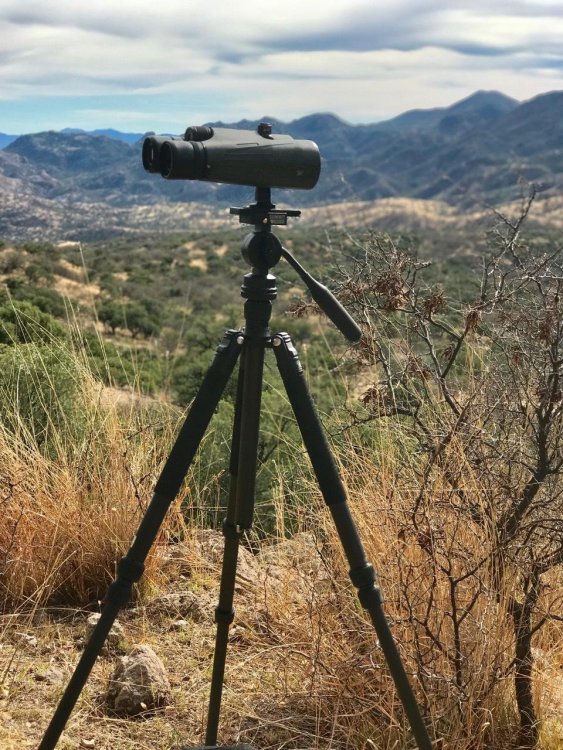
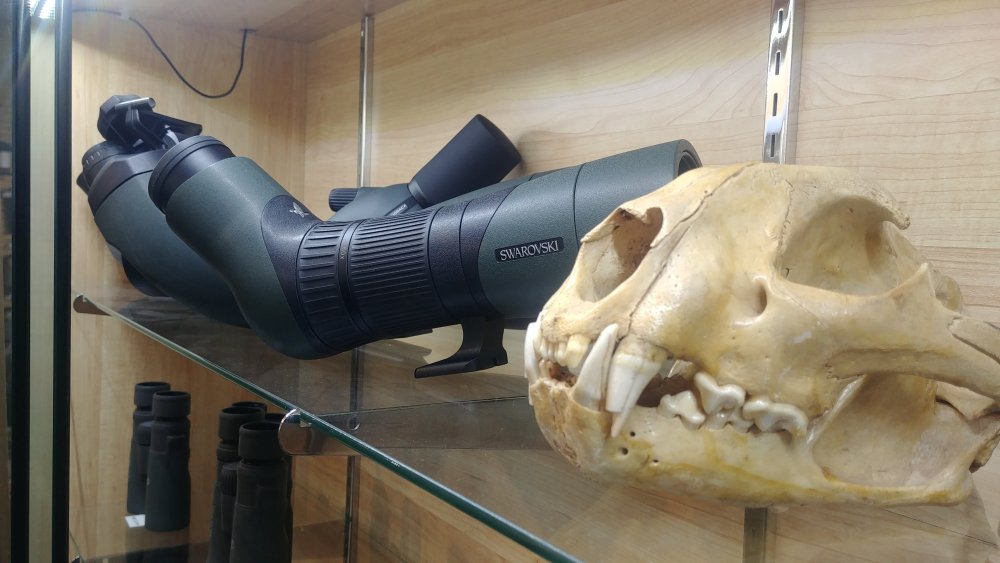
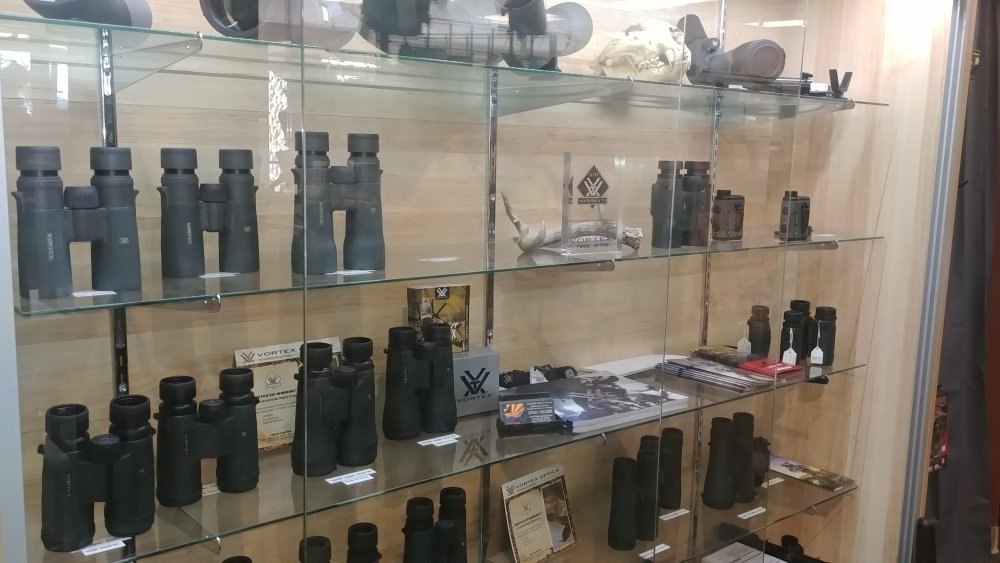
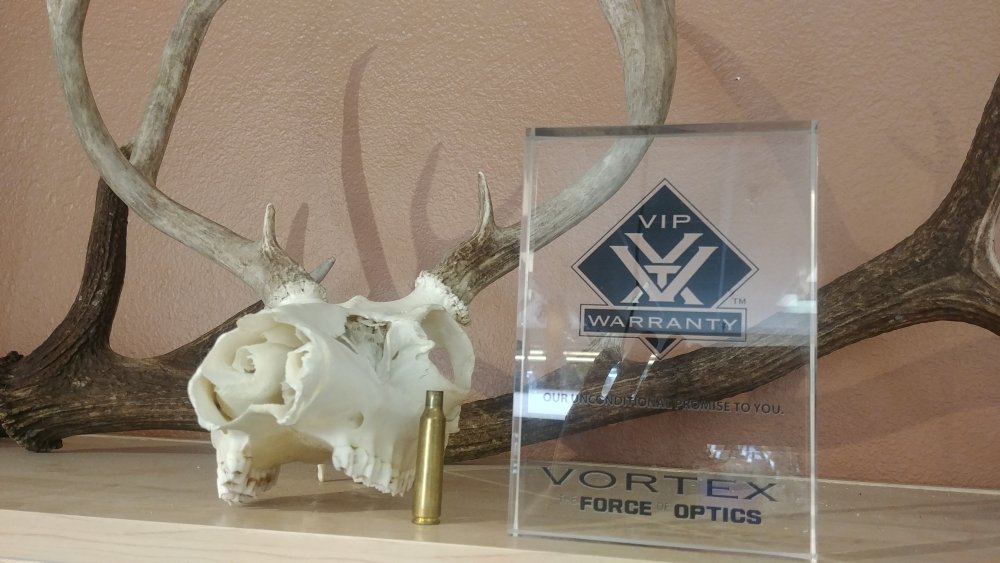
Arizona Field Optics is located at 1046 Willow Creek Road, Suite #105, Prescott, AZ 86301. Phone number is 928-778-1500. Arizona Field Optics is located inside of Jay’s Bird Barn in Prescott.
Ruger Scout 308 for sale
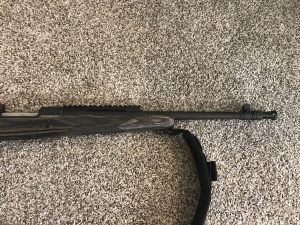
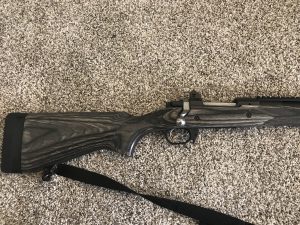
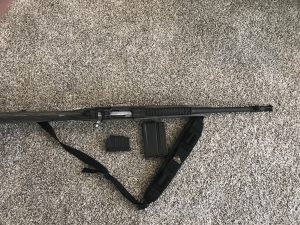
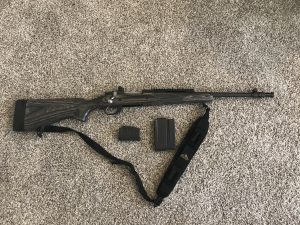 Ruger Scout 308 for sale asking $650 call/text: +1 (928) 24O-3O67 thanks
Ruger Scout 308 for sale asking $650 call/text: +1 (928) 24O-3O67 thanks
weatherby 7 mag
weatherby 7 mag,1 year old, muzzle break, 30mm tally rings and bases, No scope
480-268-0380 $750.00
For Sale
Brand new never opened FoxPro Fusion call. First $200 takes it – 4804628476
Jason March Unit 33 Nov 2016
Jason took this 100 inch+ buck in unit 33 Az on 11-8-16 with my 7-08 T/C at 318 yards. He caught 2 bucks about the same size bedded down on a really windy day under a tree and he was lucky enough to get this guy!
95 Toyota 4Runner
I have a 95 Toyota 4Runner with 244000 miles it is 5 speed 4×4 I has brand new tires the interior is in good condition the driver seat has a tear in it from sliding in and out truck runs great looking to get 3200 boo any questions feel free to text me at 4803401072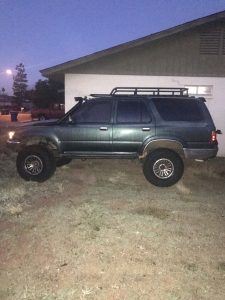
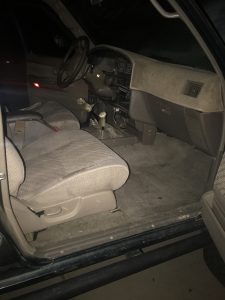
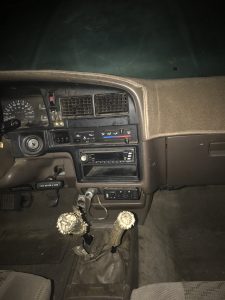
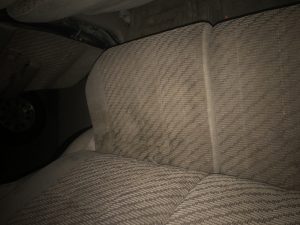
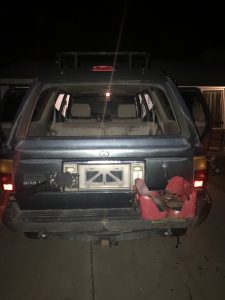
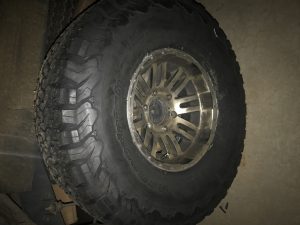
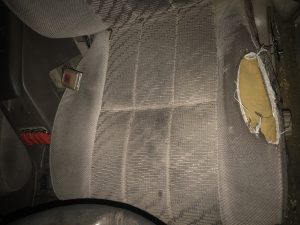
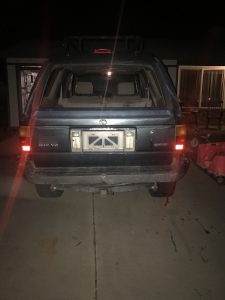
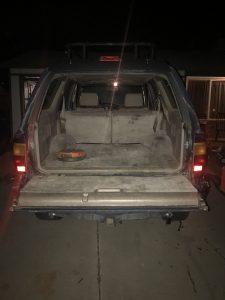
30A AZ Tio Che Juan and Manuelito 11-26-2016
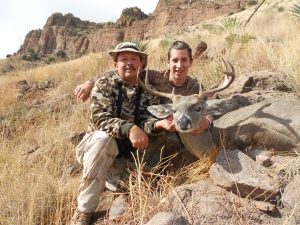
I took out my nephew again for the third year in a row and was able to put him on this extra wide buck. Manuelito gave us (Dad, Brother and Me) a little scare and the buck almost made into the next canyon but Manuelito was able to connect with his .270 Way to go Manuel!
Unit 27 NM 11-20-2016 Che Juan
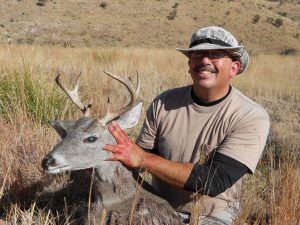
Got off to a late start and there were hunters everywhere. There were hunters to the left and hunters to the right, even in my secret spot. I was able to find this buck hiding in a grove of trees where I had seen bucks before and I had watched a group of hunters pass within 100 yards from him.
Wilderness Athlete Job Opening – Graphic Design/Marketing Assistant
The ideal applicant would have the following qualifications and would be able to work full-time in house at our Fountain Hills, AZ Headquarters.
· Highly proficient in Photoshop, InDesign, Illustrator. Graphic design skills are a priority for this position.
· Experience in web design including some knowledge of HTML, CSS, WordPress and E-commerce platforms.
· Ability to collaborate with other members of the marketing team to contribute to new ideas, promotions, product designs, etc.
· A love of the outdoors and a passion for living a healthy lifestyle.
Please send a resume and portfolio to careers@wildernessathlete.com.
2017 Women’s Javelina Hunting Camp
Women’s Javelina Hunting Camp 2017
Unit 36A/B/C Adult Women’s Javelina Hunt Camp – February 16-19, 2017.(plan to arrive the night of the 16th if you can, or if you want to come earlier, call me and let me know, Amanda – 928-200-0544)  Students and Mentors, please fill out a form and email back to me, amanda@coueswhitetail.com
Students and Mentors, please fill out a form and email back to me, amanda@coueswhitetail.com
Are you a woman interested in learning how to hunt? Then this camp is for you!!
The goal of this camp is to provide a safe and fun hunting experience for novice adult women hunters (18 years of age and older). We plan to match up experienced hunters (mentors) with novice women hunters (students). The novice hunters will be able to learn everything necessary for hunting javelina. And many of these skills can be applied to hunting other game animals. Learn more about javelina, how to hunt them, and some tasty recipes for cooking javelina at http://www.javelinahunter.com/
The AGFD has a short video about javelina. http://www.azgfd.gov/video/javelina.shtml
This camp is made possible through a grant from the Arizona Game and Fish Department and the support of the Arizona Chapter of the Safari Club International, CouesWhitetail.com, Southern Arizona Chapter of the National Wild Turkey Federation, Young Gunz Outdoors, Arizona Outdoor Women, Pass it On Outdoor Mentors, and numerous outstanding volunteers.
Pre-registration is required! Enrollment for this camp will be limited to 30 adult women hunters. There is no cost to attend the camp, however in order to secure a spot at this camp, you must pre-register and you must purchase an AGFD hunting license and javelina tag for the Handgun, Archery, Muzzleloader hunt in Arizona hunt units 36A, B, C (hunt number 5076 or 5077 or 5078). Need help figuring out how to get a tag? Call Dewane Tabbot at Mesa AGFD office and he will help you out: 480-981-9400. We will not save a space for you at this camp if you have not pre-registered. We need to get a good head count for this camp so that we can make sure we have enough mentors and meals for everyone. Having a required pre-registration will assist us with this. All food and coaching will be providing free of charge to all participants at this camp.
Please remember this hunt is geared toward teaching first-time hunters and novice hunters how to hunt. Since space is limited, we give preference to those with the least experience. We strive to provide a 1 to 1 student to mentor ratio, but we do not guarantee that. Students who have not previously attended the camp and those with the least experience will be given preference with regard to mentors. Those who have attended the camp multiple times or who already have significant experience hunting may be put on a waiting list and allowed to attend the camp if space is available. The focus of this camp is to recruit new hunters and give support to those still learning to hunt.
To sign-up for this camp, please use this form. I would like mentors and students to fill out this form. You may complete the form electronically and email it back to me, or you may print it out and mail it to me using the address on the form. Please turn in that form as soon as you know you want to attend so that we can reserve a spot for you!
Questions?? call or email Amanda Moors (amanda@coueswhitetail.com, 928-200-0544)
Need help figuring out how to get a tag? Call Dewane Tabbot at Mesa AGFD office and he will help you out: 480-981-9400.
Anyone wishing to take a hunter education/safety course may find one here: http://www.azgfd.gov/i_e/edits/hunter_education.shtml There are several classes available that will be completed by the time this hunt comes around in February. You may also take the class online at your own pace. I highly recommend taking a hunter education class if you have not already (however, this is not required by adults attending this camp).
How to get a leftover tag for this hunt: Leftover hunt permit-tags can be obtained two ways. Beginning in late November, Game and Fish will accept applications by mail only in the same way as the regular drawing process. Then in early December, leftover tags are also available for purchase in person from any of the seven Arizona Game and Fish Department offices. A list of office locations is available at www.azgfd.gov/offices. Just drop by one of the AGFD offices and tell them what you want and they will get your squared away.
Please read the spring hunt regulations put out by AGFD
What is included at the camp: All your meals and drinks (non-alcoholic) will be provided. Every student that has a license and tag will be able to go out hunting with a mentor. We will strive for a 1:1 ratio of students:mentors, but we can’t guarantee that at this point.
 You may bring your own tents, trailers or RVs to camp in. If you need camping gear, contact Amanda
You may bring your own tents, trailers or RVs to camp in. If you need camping gear, contact Amanda
Tentative Camp Schedule (you may show up at camp at anytime and leave whenever you need to, but please let Amanda know what day and time you plan to arrive and let her know when you leave)
Thursday – Feb. 16, 2017 – Arrive in the afternoon/evening to set up camp and get ready for the hunt the next morning. If you can arrive earlier in the day, you might be able to hunt since the season will be open. Please coordinate with Amanda if you plan to hunt on Thursday.
Friday – Feb 17, 2017 –
Breakfast – 6 am to 7 am Hunter Safety Talk – for those that missed this the night before
Morning hunt
Lunch – 11 am to 1 pm
Afternoon hunt
Dinner – 7:30-8:30 pm
Saturday – Feb 18, 2017
Breakfast – 6 am to 7 am
Morning hunt
Lunch – 11 am to 1 pm
Afternoon hunt
Dinner – 7:30-8:30 pm
Sunday – Feb 19, 2017
Breakfast – 6 am to 7 am
Morning hunt
Lunch – 11 am to 1 pm
Pack-up and head home or Afternoon hunt for those who wish to stay
What you need to bring:
Personal Items: clothing, toiletries, sunscreen, hats, gloves, etc. It will likely be freezing at night and the early mornings, so please bring warm clothes. A camera is nice for recording some memories. A flashlight or headlamp will be useful at camp and during the hunt. Good hiking boots are recommended. If you are a light sleeper, you may want to bring earplugs as there may be people who stay up later than others at camp. We will also have generators running at times.
Camping equipment – tent, sleeping bag, sleeping pad. If you need some camping equipment, please let Amanda know(amanda@coueswhitetail.com) and we will see if we can find some to loan you. You will probably want to bring an ice chest in case you get a javelina and want to transport the meat and hide home.
Hunting Equipment — backpack, hunting clothes (camo is best), a weapon and ammunition (handgun, archery or muzzleloaders only), knife, binoculars. If you have a tripod for glassing, you will want to bring that too. A range finder is very helpful also for judging distance of the animals for a shot. You should also bring a gamebag, some large ziplock bags, and a cooler to put the meat in. You may also want to bring a pair of small rubber gloves to wear while cleaning the animal.
A Positive Attitude!! It is important that everyone come with a positive attitude and an open mind, ready to learn. We also ask that everyone be respectful and helpful to everyone attending this camp. We expect 60-100 people at this camp and so we ask that you go out of your way to maintain good relations with everyone. We want everyone to have a great time and a little courtesy will go along way.
Photo of the Babaquivari Mountains.
Location of the camp:
We will be camping on the beautiful Buenos Aires Wildlife Refuge. For more information about the refuge, visit their website:http://www.fws.gov/southwest/refuges/arizona/buenosaires/
There are special rules that apply when hunting and camping on the refuge. Javelina hunting is allowed on the refuge, but you may not hunt quail or some other species. We will be hunting on both US Forest Service Land as well as the Refuge, so different rules apply depending on the agency that oversees the land.
Directions from Tucson, AZ: From Tucson….go south on I-19 and go (about 33 miles from I-10) to the Arivaca Junction Exit 48. At the stop sign on the off ramp take a right to the next stop sign and then take another right and take your first left on to Arivaca Road and head west to the town of Arivaca about 23 miles or so, drive through Arivaca and stay to the right as the road drops down slightly after you pass the store with the only gas pumps, then drive for about 8-9 miles and take a right on to the High Gate North dirt road (there is not a sign, but there are some green fence poles there at the turn). The High Gate North road is between mile markers 3 and 4 on the Arivaca-Sassabe road, closer to mile marker 3. The main camp will be at or near camp spot 38. There will be numerous camping spots around there so we can spread out.
You may also reach the camp by coming south on highway 286 from Three Points. Around mile marker 12, you will see the Arivaca-Sassabe road that heads east from 286. Turn there and the High Gate North dirt road (there is not a sign, but there are some green fence poles there at the turn) will be located on the north side between mile markers 3 and 4 (closer to 3). The main camp will be at or near camp spot 38. There will be numerous camping spots around there so we can spread out. (see map above for more details).
Welcome Q5 Outdoor Products as a new sponsor!
Please welcome Q5 Outdoor Products as a new sponsor of CouesWhitetail.com! Q5 is owned by Dan and Joanne Priest and those of you that are small game hunters will love the products they make and sell. They are known for high quality small game vests. Right now, they make five different, high-quality vests to meet the needs of a variety of hunters.
The goal of Q5 Outdoor Products is to provide high-quality, functional upland bird hunting vests that are increasingly modular and semi-customizable. The vests are manufactured in the USA and in fact are designed and manufactured in Arizona. Q5 Outdoor Products also strives to provide an unprecedented level of customer service.
I first met Dan Priest many years ago while out hunting on the San Carlos Reservation. He told me all about his non-profit organization called Arizona Outdoor Adventures, which is dedicated to providing healthy outdoor activities that enrich and positively impact the lives of children. Dan and Joanne use a portion of their profits from the Q5 Outdoor Products business to support the non-profit Arizona Outdoor Adventures. So when you buy one of their vests you can feel good that some of the money is going to support getting kids outdoors! Please visit their website to learn more about their non-profit and please help support them as they work hard to get kids connected to the outdoors. http://azoutdooradventures.org/
Dan has received the KNIX Local Hero award as well as recently being inducted into Arizona’s Outdoor Hall of Fame because of his tireless work to provide the beauty, peace, and healthy activities available in the great outdoors to children – especially disadvantaged children here in Arizona.
Q5 also supports many wildlife conservation groups like Quail Forever by making donations to their fundraising banquets.
But back to the Q5 products….You might be wondering why the business is called Q5….the “Q” stands for quail and the 5 represents their five grandchildren. Dan has been an avid quail hunter for decades and he realized that he could create a better vest for small game hunters and use that business to help support his non-profit. And so in 2012, he launched Q5 Outdoor Products as an online business.
If you are a small game hunter, you will surely appreciate the vests that Q5 is making and the other products available on their website! Check out their website and see if you agree!
Q5 Outdoor Products is frequently adding new products to their website and they are currently working on designing an Upland Bird Belt and a Dog Trainer’s Bag. So keep your eye on this website for new products!
What do customers say about their products?
– Q5 Centerfire:
“I received my vest today, after only ordering it Thursday…just wanted to let you know how impressed I was with your customer service, the professionalism of your company, and the outstanding craftsmanship of your product I will be highly recommending you to everyone I know, or anyone who asks… I would say I would purchase from you again, but I believe that it will be a long long time till I need another vest after receiving this one. Thanks for making this purchase a pleasant experience.” ~ Travis
“I just wanted to thank you guys for a wonderful shopping experience. I received my upland vest last night and couldn’t be happier with the quality/utility of the product. More important/rare was the customer service I received along the way. Even though the product was backordered, you were open, honest, and accessible with your communications. I do the majority of my shopping online and this was truly a standout experience. Thanks again.”
~ Jeremy
“Received the vest…and carrying bag (that was unexpected : ), in good order. The vest is much more than I had expected, particularly quality wise! You design and build a great product. A lot of the other uplanders got to try it on, and we’re also impressed. It received nothing but kudos!
– Quilomene Upland:
I will highly recommend it…I have also found a way to put my Citori Lightning 20ga. in it for long carries into, or out of, (after I get my limit of course) the field/hunt area.
“Thanks for the great customer service! I love the vest. Haven’t tested it in the field yet (can hardly wait ’til September 1st), but have shot a 10-station, 100 target round of sporting clays – it was convenient, comfortable, and easy to shoot in. Thanks again!” ~ Daniel
– Quilomene San Carlos H-back and Y-back:
Sooooo the new Q5 Quilomene San Carlos II (H-Back) showed up at my office today…all I can say is holy crap…this is the best bird vest I’ve ever seen…and those of you that know me, know I’ve been praising the Quill stuff since 93 (and yes, I’ve tried most of the other major strap vest players made in the last 2 almost 3 decades )…The II (H-Back) is a significant improvement over the original…and an improvement over Q5’s first rendition of the SC. I’ll post the pictures of the one that showed up later. ~ Woodcock Limited Of New England
“I’m ecstatic about my new vest! I was given my original Quilomene San Carlos vest as a gift for suturing up a dog in the field for a guy 14 years ago. I was so bummed when Steve stopped making them and I’ve been searching for a compatible hunting vest. . . . I saw your vest on Facebook via friend Tim from New England and ordered one that day. The vest and the added touches…the bag it came, the warrantee card tied with brown twine, and the key holder are world class! No company has ever had such nice touches!!! I will certainly be blogging about your vest at www.uplandways.com and my quail chasing excursions!” ~ Shawn
For further reviews/comments, go to www.q5outdoorproducts.com
Also visit www.facebook.com/Q5OutdoorProducts
Mike Way – San Carlos 2015
Congratulations on another fine buck Mike! Mike said this buck he got on Mt Turnbull had a very red tail, almost like a red fox!
He also sent in the pic with all the three bucks and the CouesWhitetail.com sticker, thanks Mike! The one on the right is Mike’s and the others deer are bucks that his friend and his son killed in 2015 also.
Unit 8 South of Williams Mule Deer
Good Evening,
Is anyone seeing any bucks in unit 8? I have a hunt coming up in a week and haven’t found the quality of deer I hoped to find. Any advice would be appreciated!
Thank you!
Daniel
Junior Cow hunt unit 3C “Killum Guilliam Gang”
This year has been a challenge, and we were only able to scout one weekend. During Scouting Trip we glassed up 75 mule deer, one black bear, and one bull elk, and saw numerous tracks so things looked bright.
We made it up on Thursday to get in a short glassing session.. My Future son in law had purchased a bear tag since i have seen bears in the area nearly every trip into the area. As luck would have it Lane and I arrived to scout and glass, but Anthony didn’t as he had a blow out in Payson. Lane and I glassed for about an hour and kept hearing noises from the cut next to us but could figure out what it was.. Finally a 375-400 lb Jet Black Bear walked out of the brush about 300 yards from us, he stood up barked/ whoofed at us then ran up the opposite ridge. We could have easily taken this bear but the Tag holder was sitting in Payson with a Flat so we let him walk.
Opening Morning was hopping, Lane and Destry had a 380″ bull come into 10 yards… the bull couldn’t decide if he was going to charge or retreat for the longest time, but finally he retreated to top of the ridge where his cows were.
we hunted high and low, long and hard… Lane and Lillimay had missed opportunities on Saturday and Tuesday Morning.
Tuesday Evening Lane and Tucker connected on two Elk within minutes of each other, and then the work began. We had to get the Elk off the Hill and to Clints Well before the trailer closed at 9:00 PM (as the locker in forest lakes was closed) (made for a really long night/ didn’t make it back to Forest Lakes until 12:30 in the morning). Lillimay connected on her elk the following Morning around 7:00 am. Thanks to Steve Norland, Anthony Rochotte, and Skyler for Helping on the pack outs.

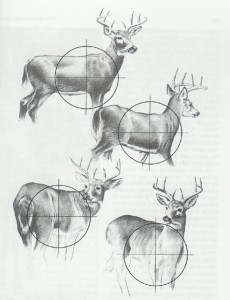
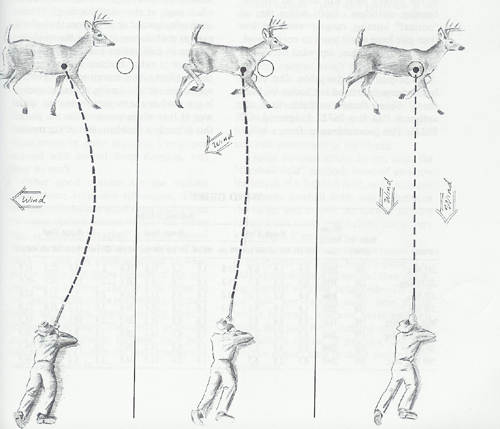
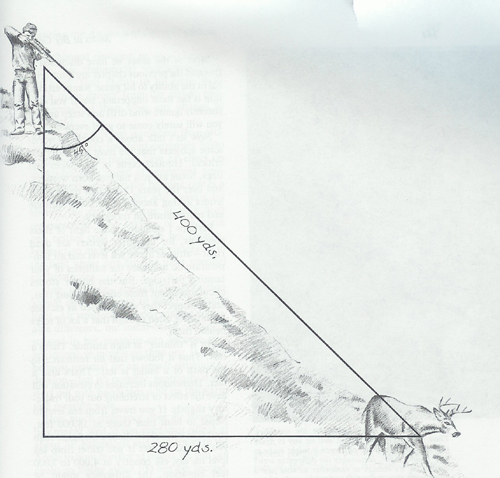
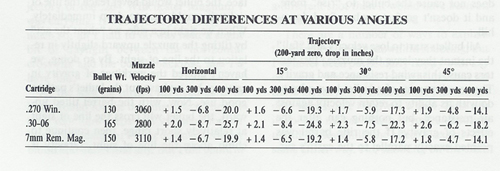
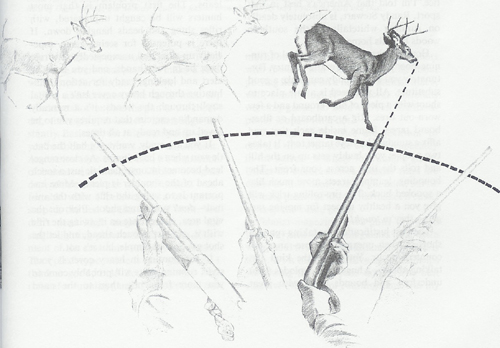
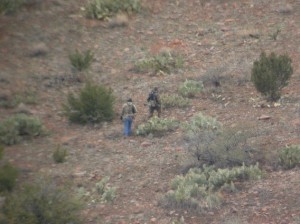
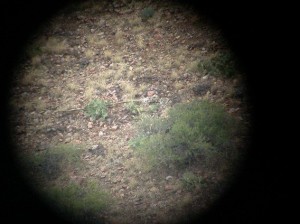
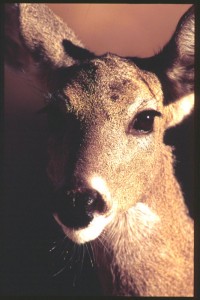
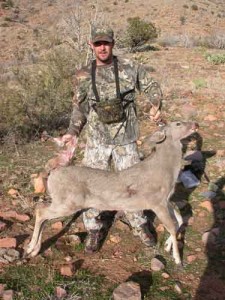
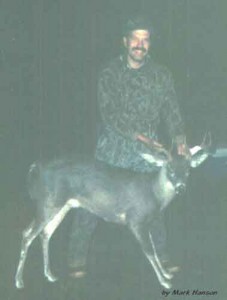
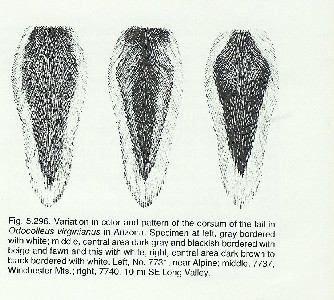
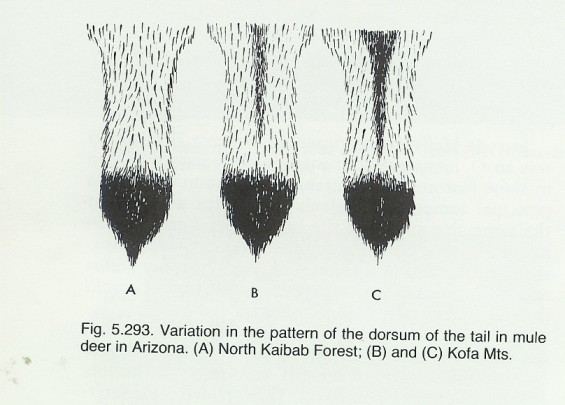
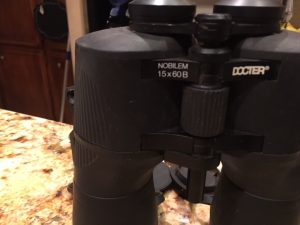
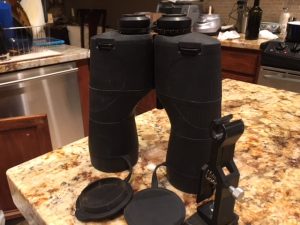
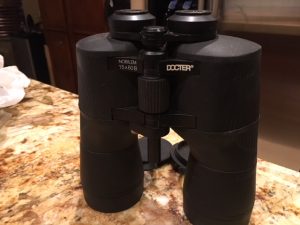
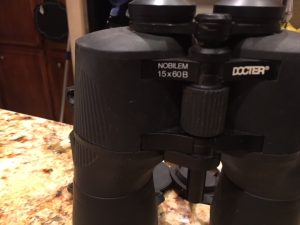
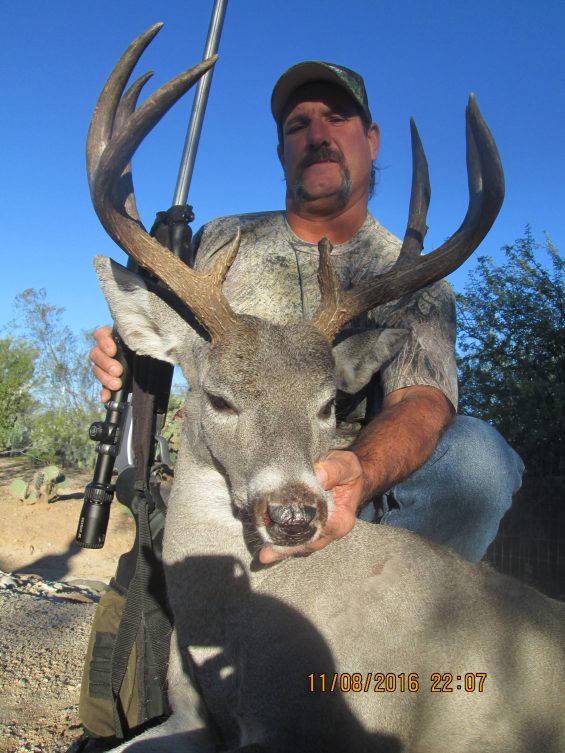
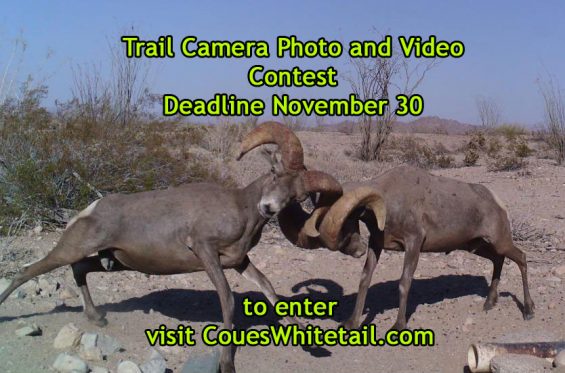

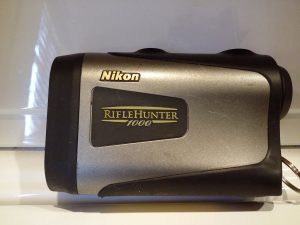
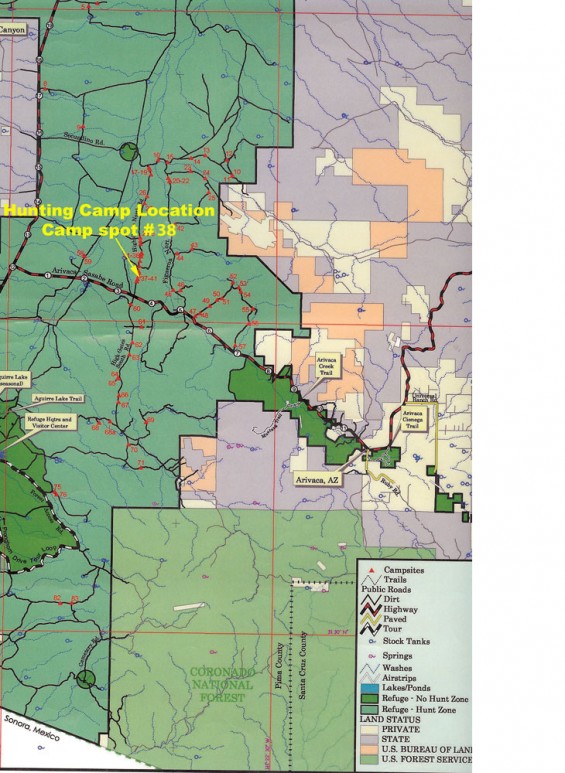
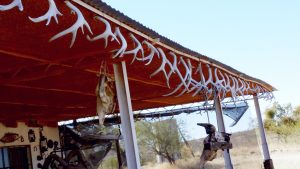
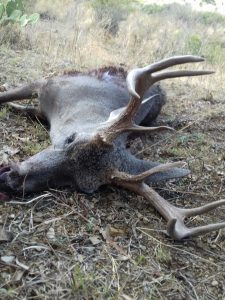
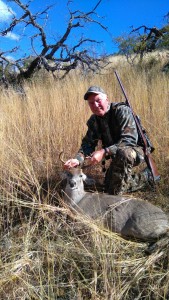
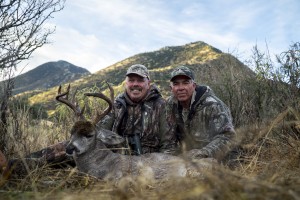
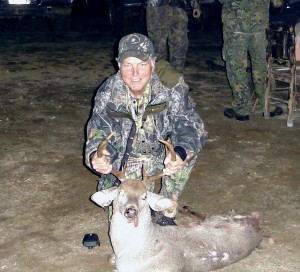
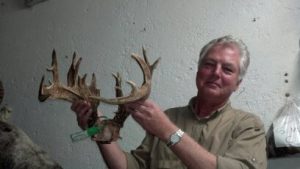
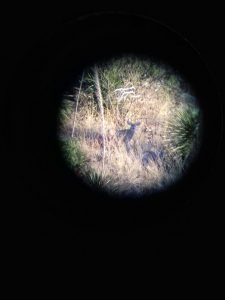
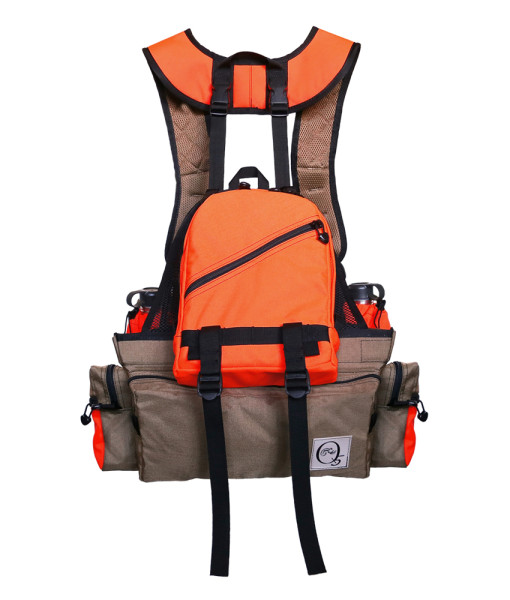
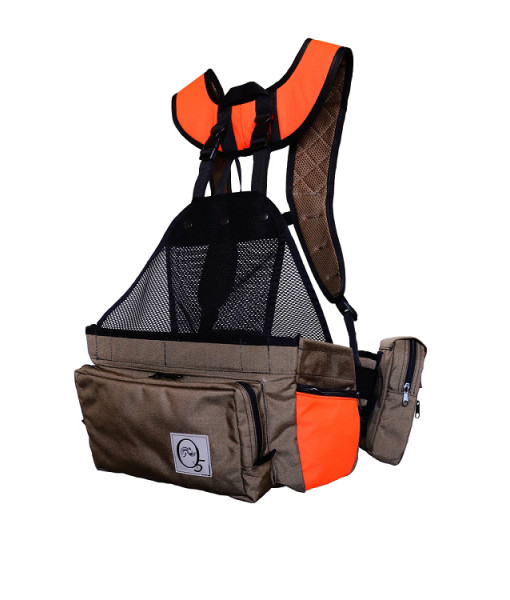
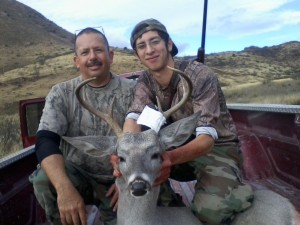
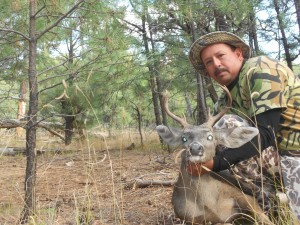
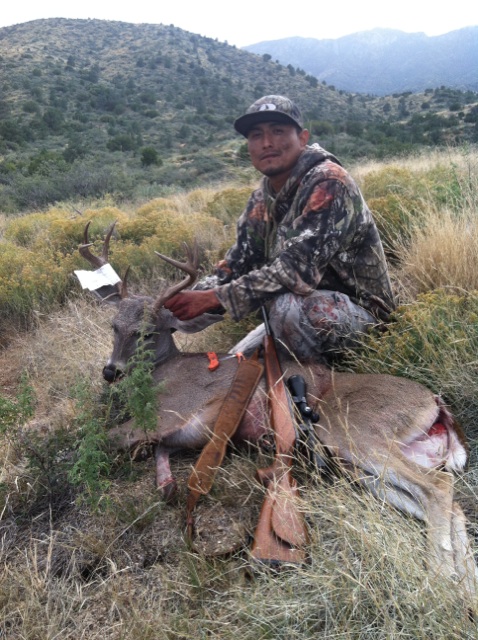
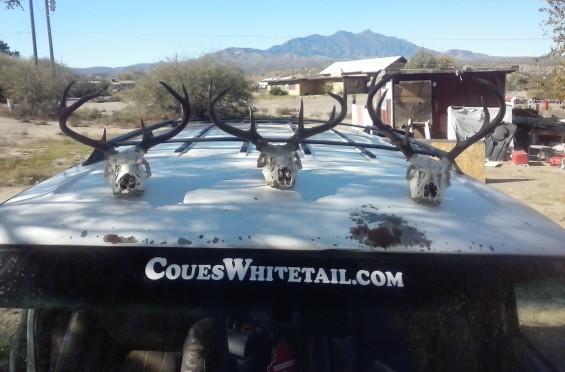
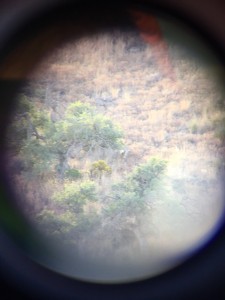
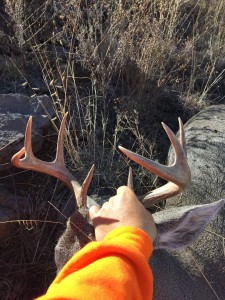
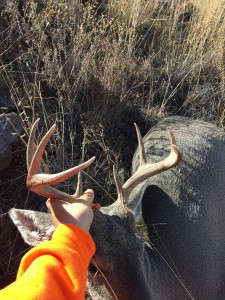
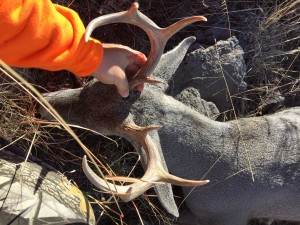
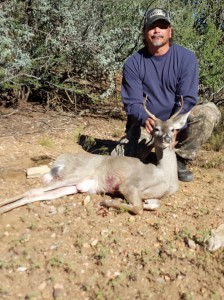
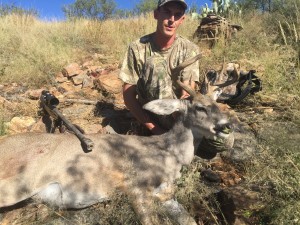
![IMG_0012[1]](https://www.coueswhitetail.com/wp-content/uploads/2015/10/IMG_00121-150x150.jpg)
![IMG_0013[1]](https://www.coueswhitetail.com/wp-content/uploads/2015/10/IMG_00131-150x150.jpg)
![IMG_0014[1]](https://www.coueswhitetail.com/wp-content/uploads/2015/10/IMG_00141-150x150.jpg)















